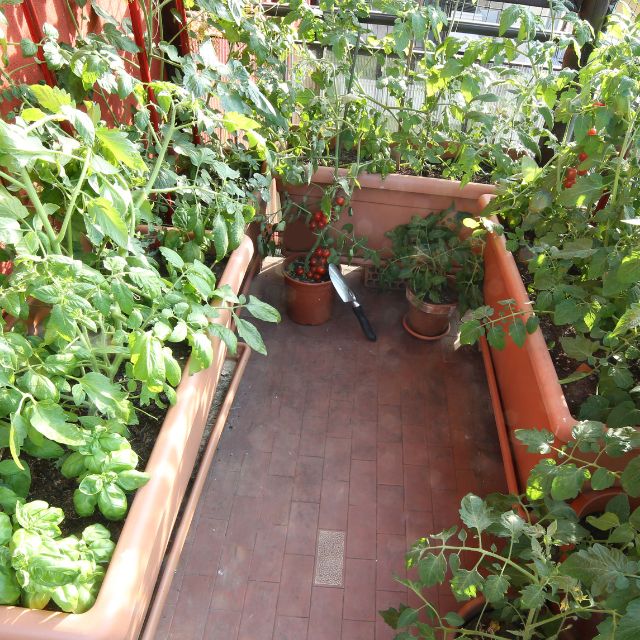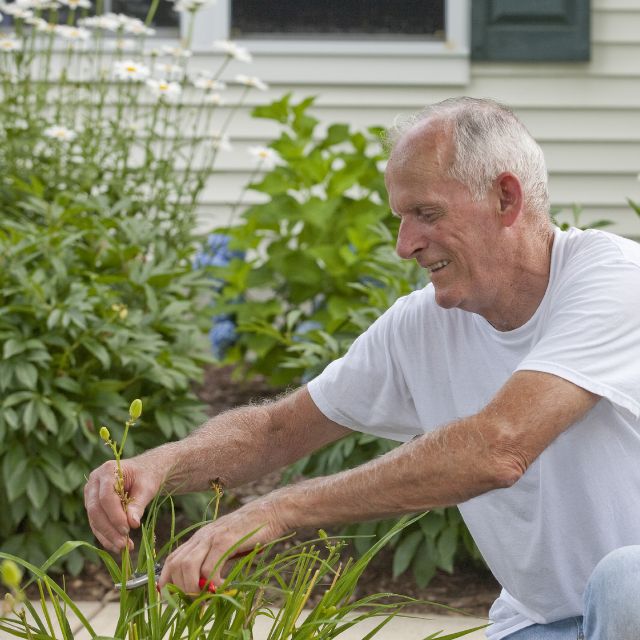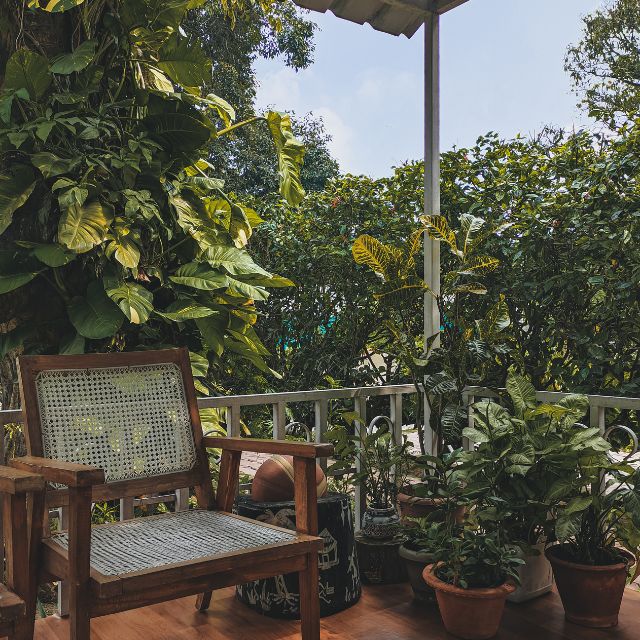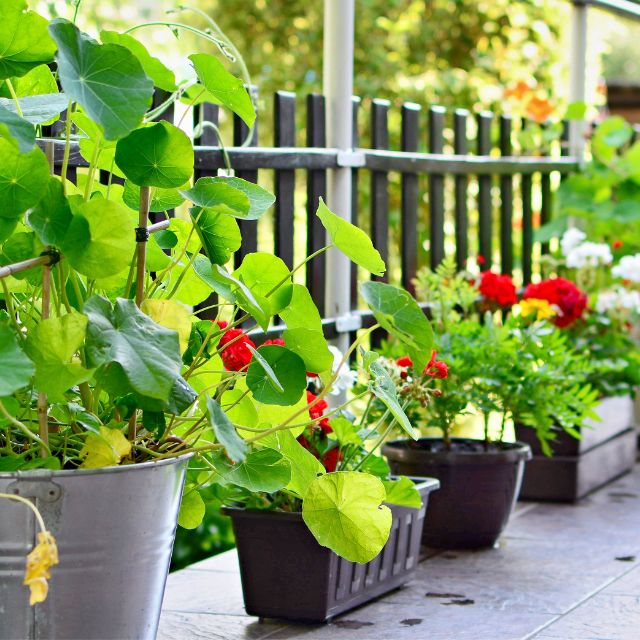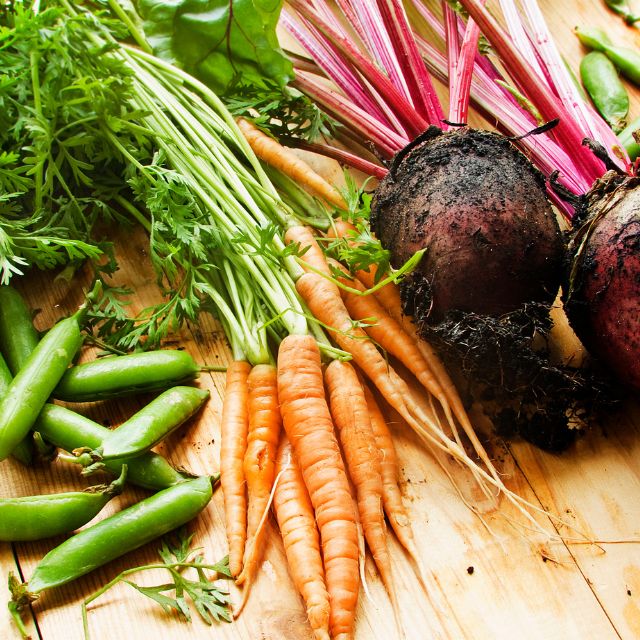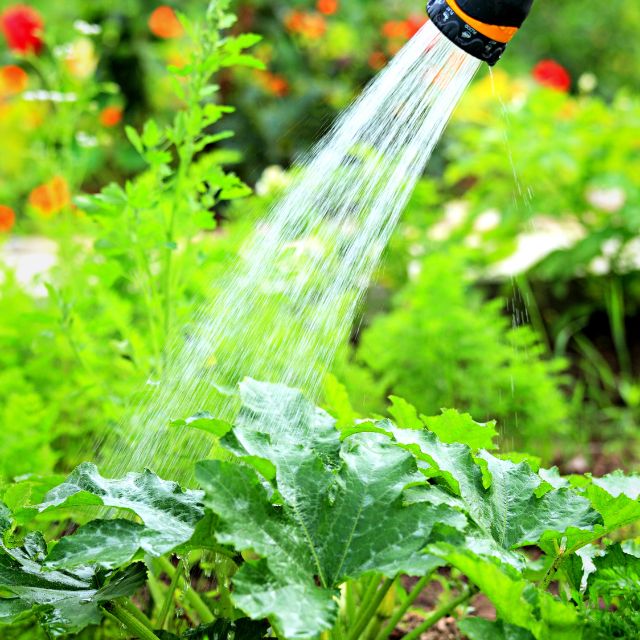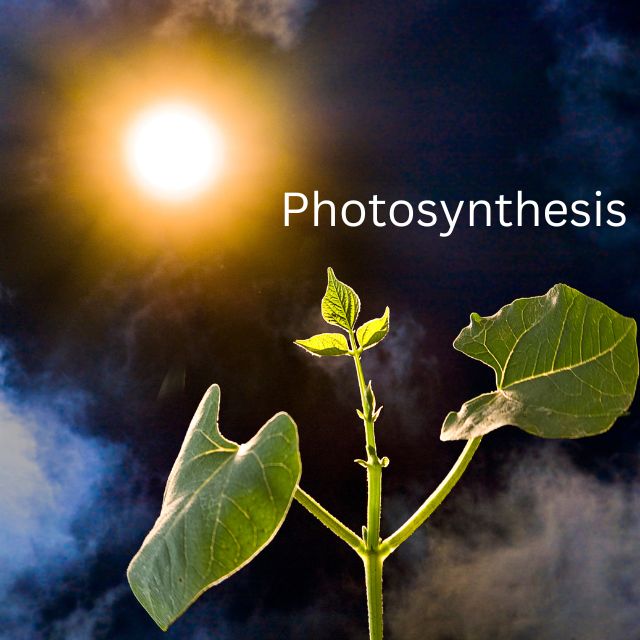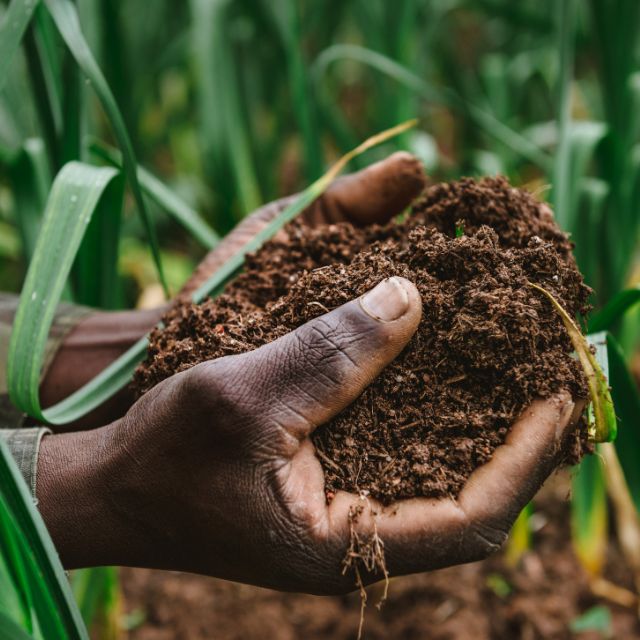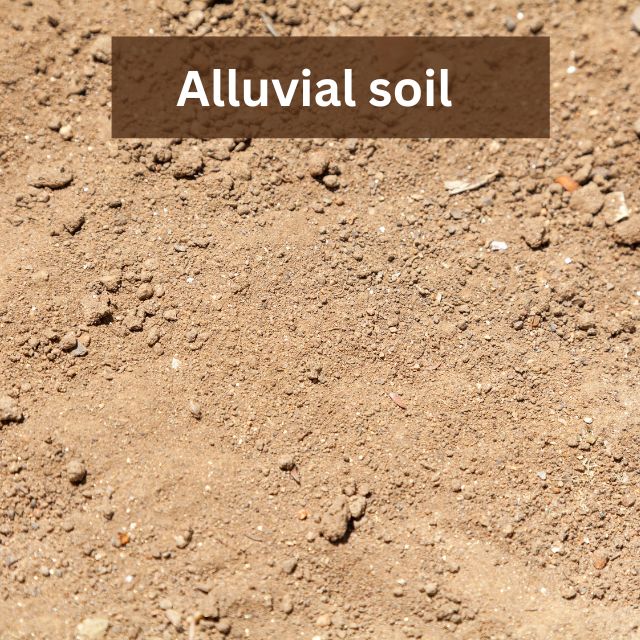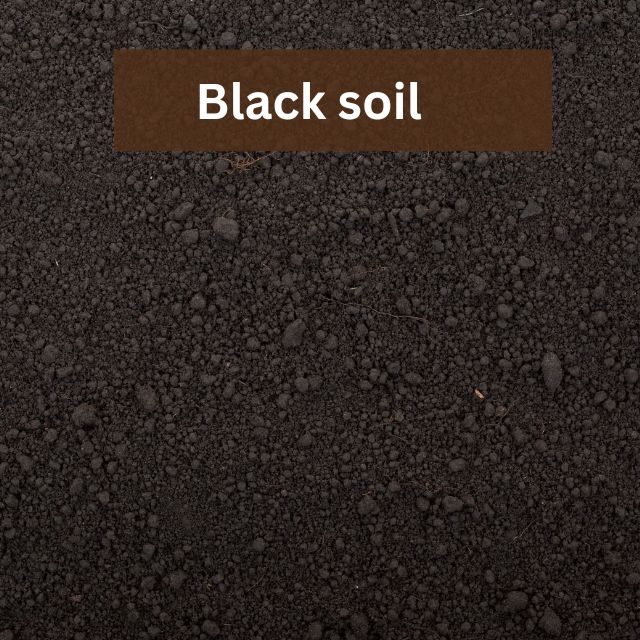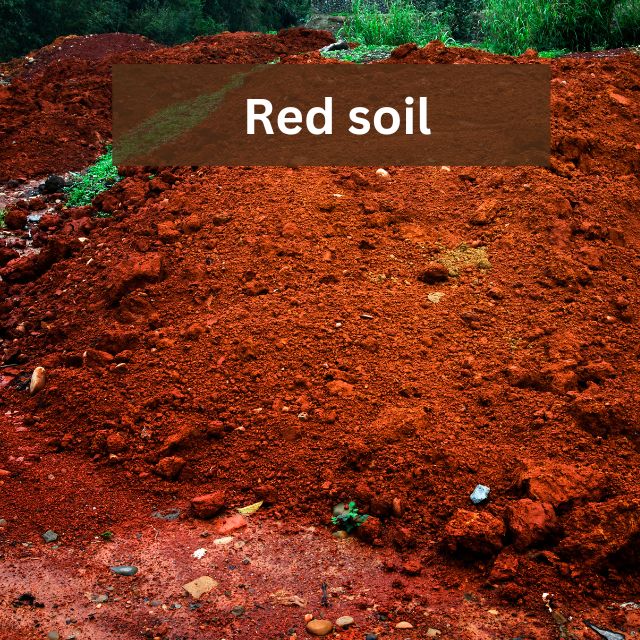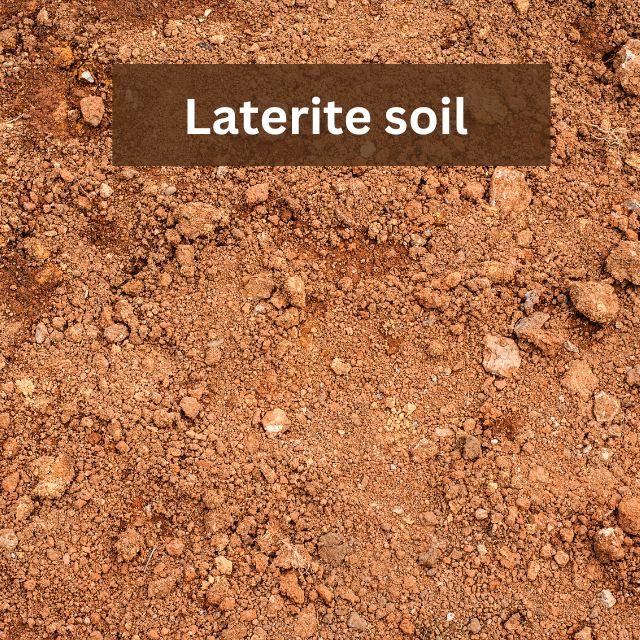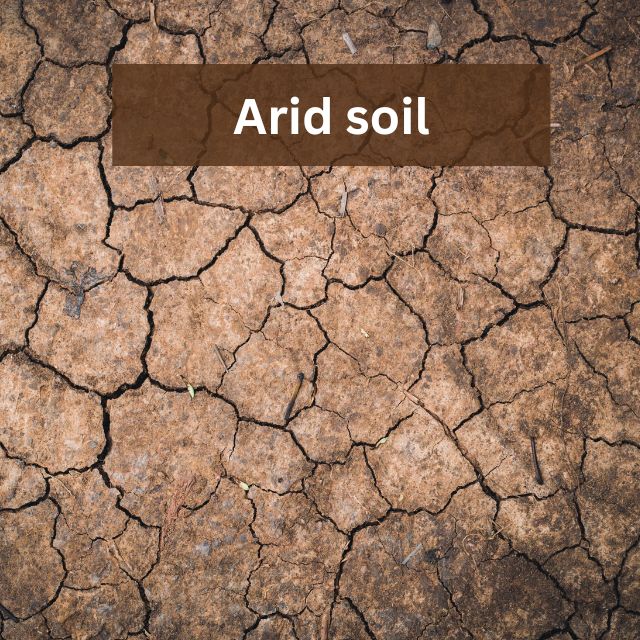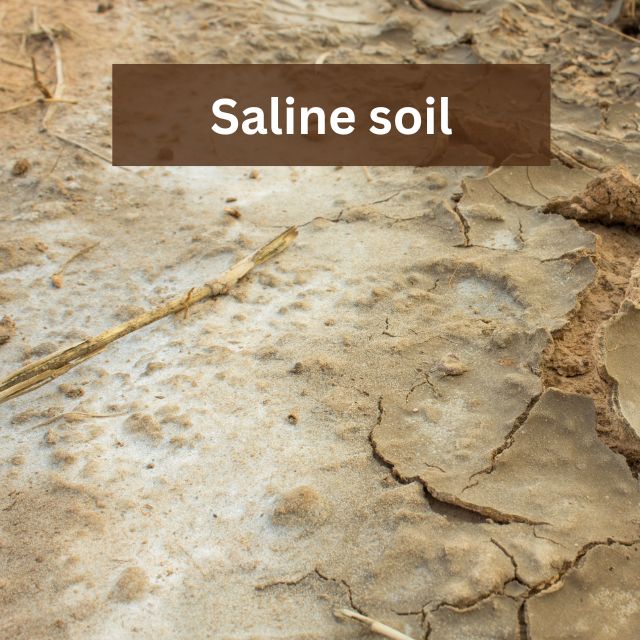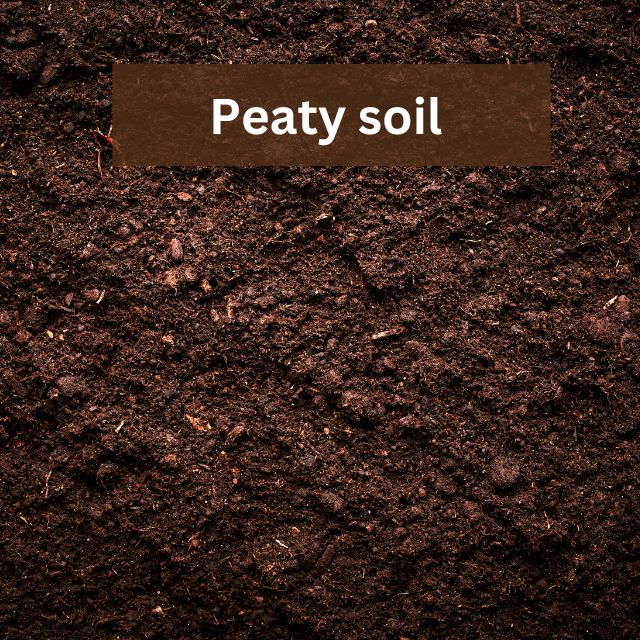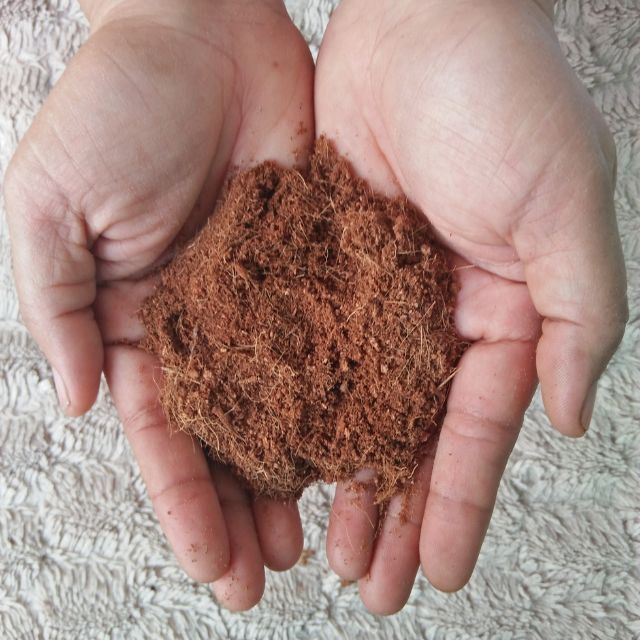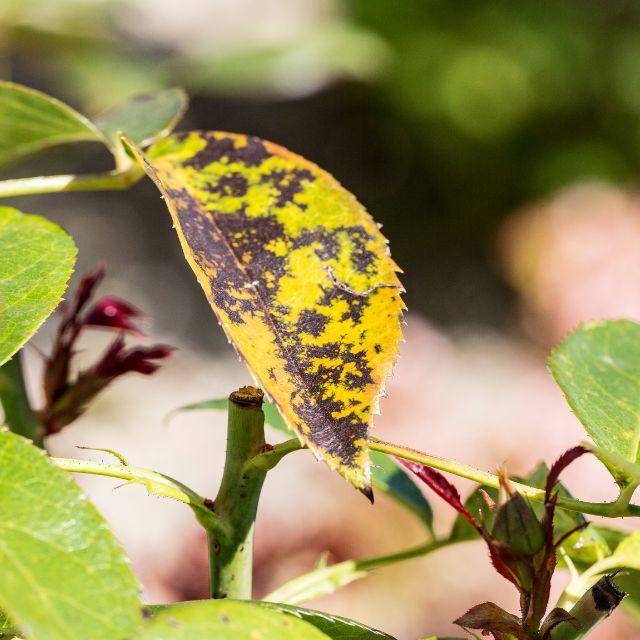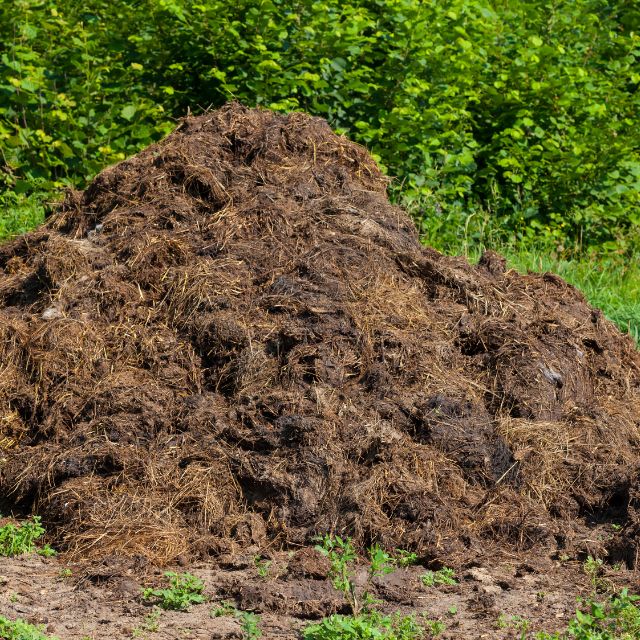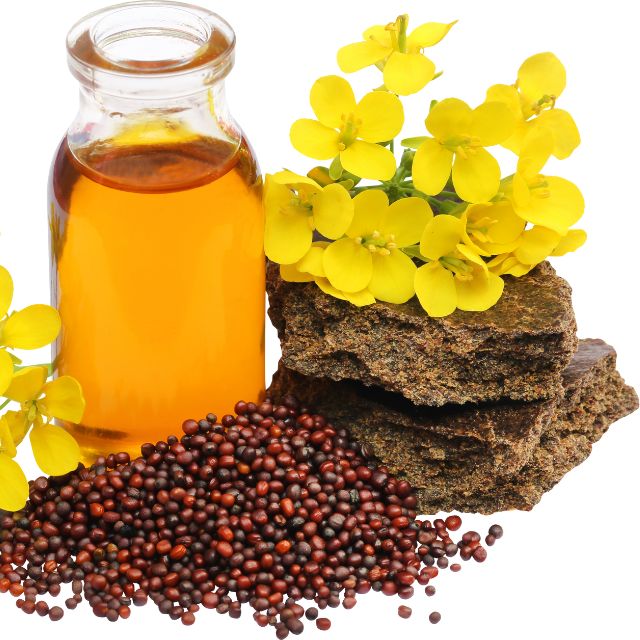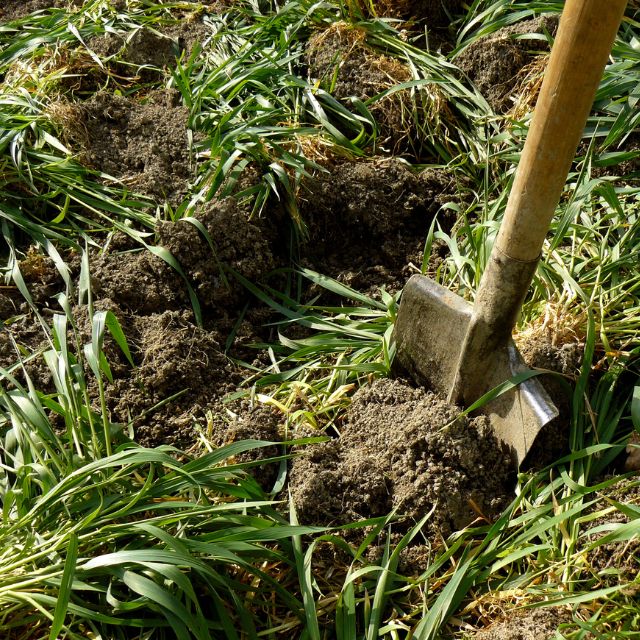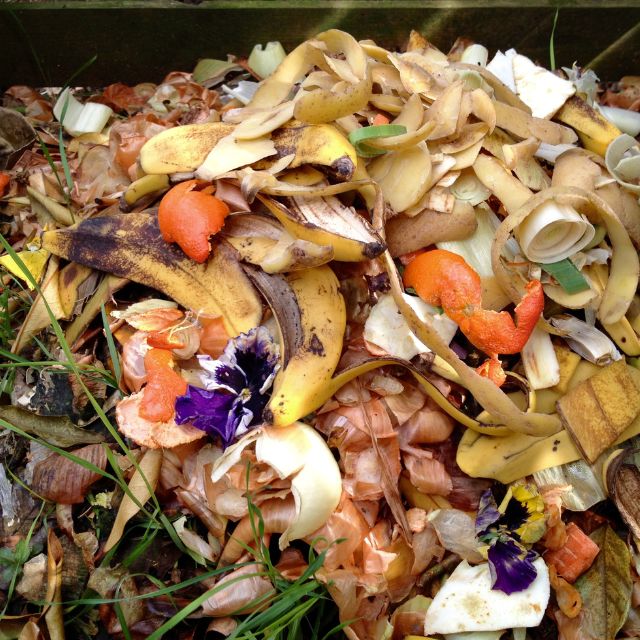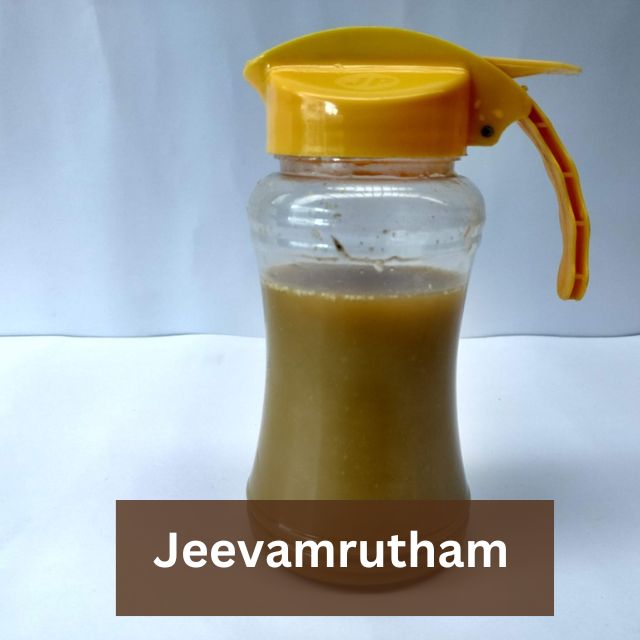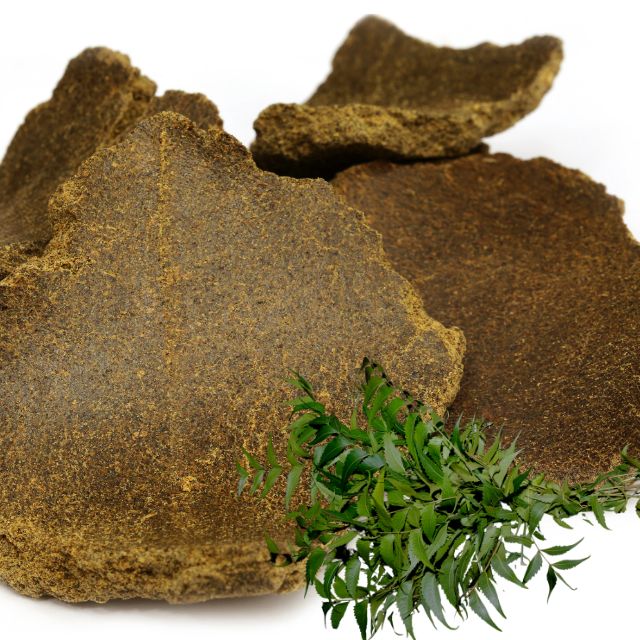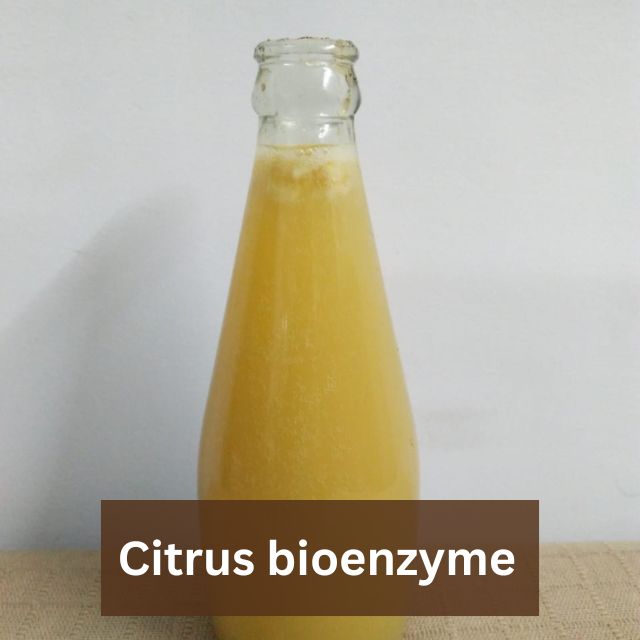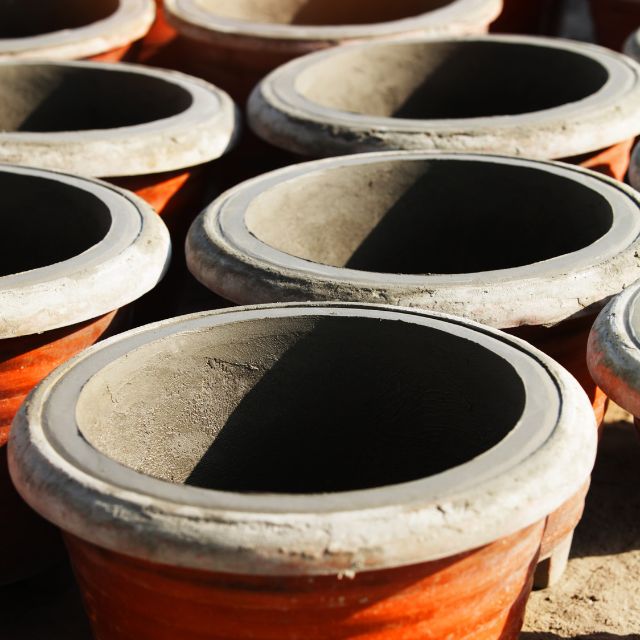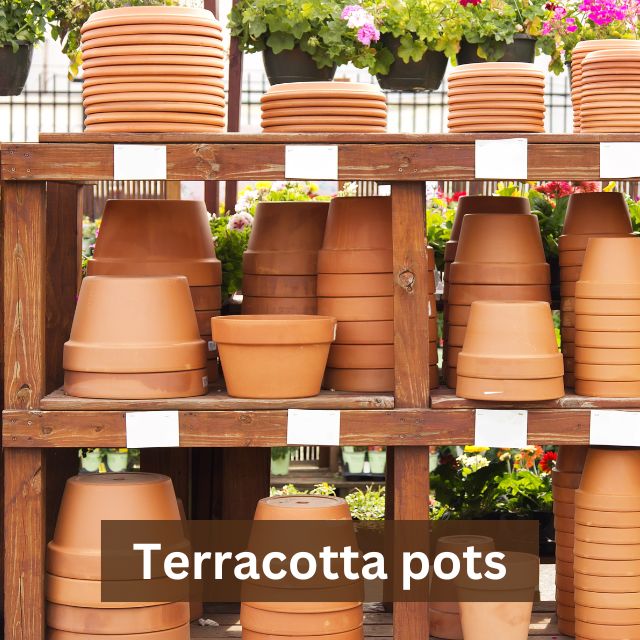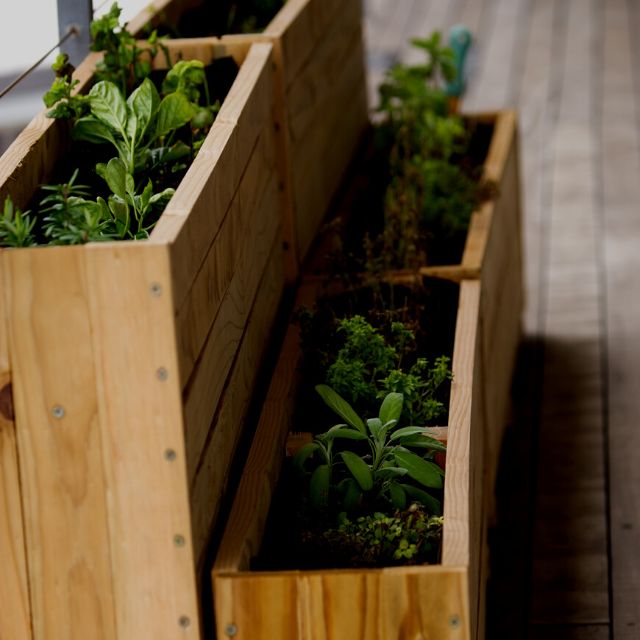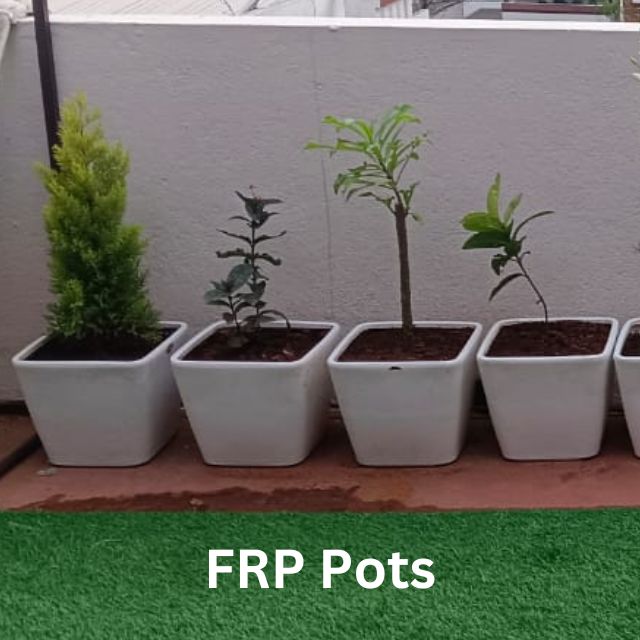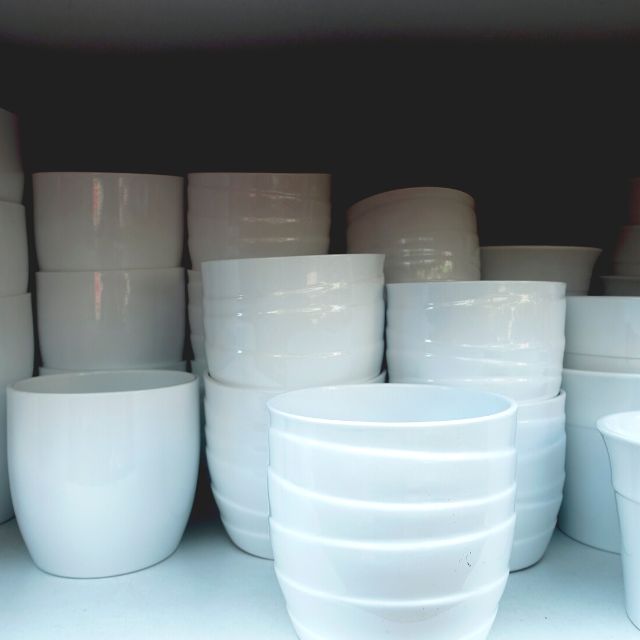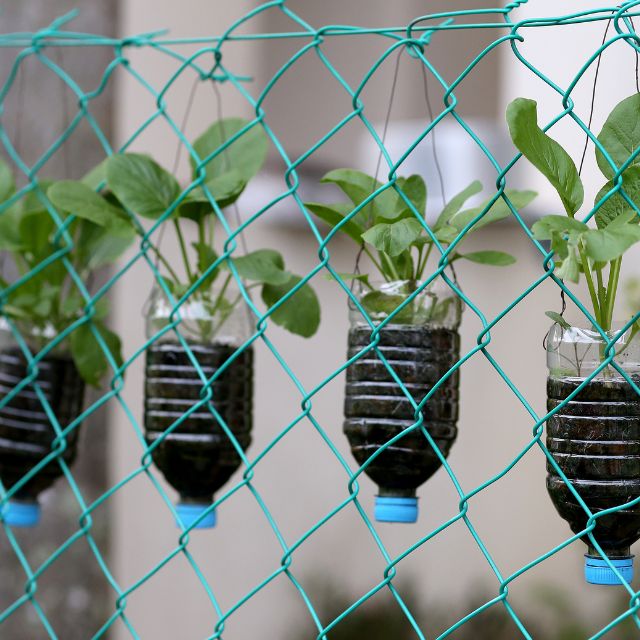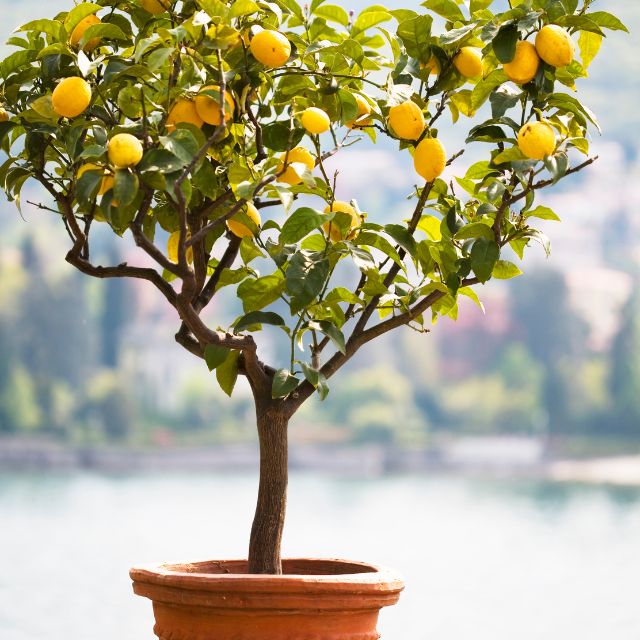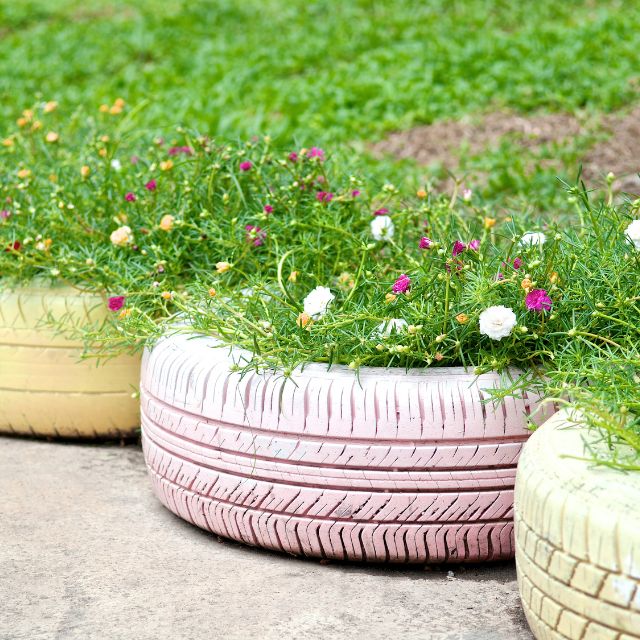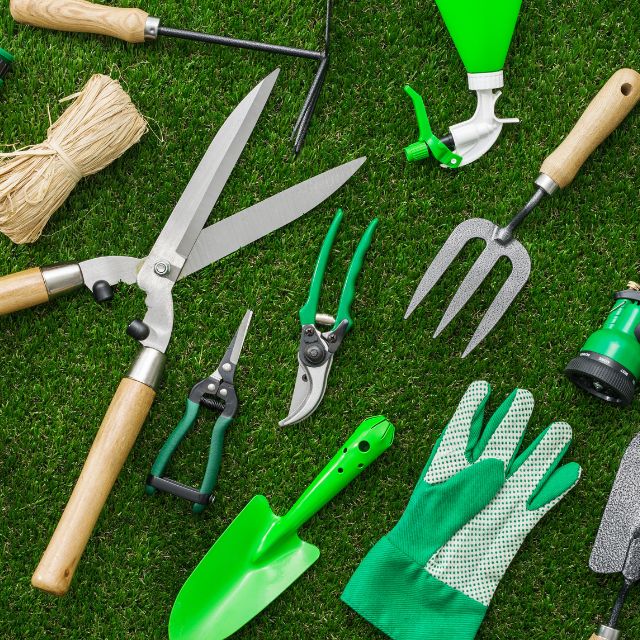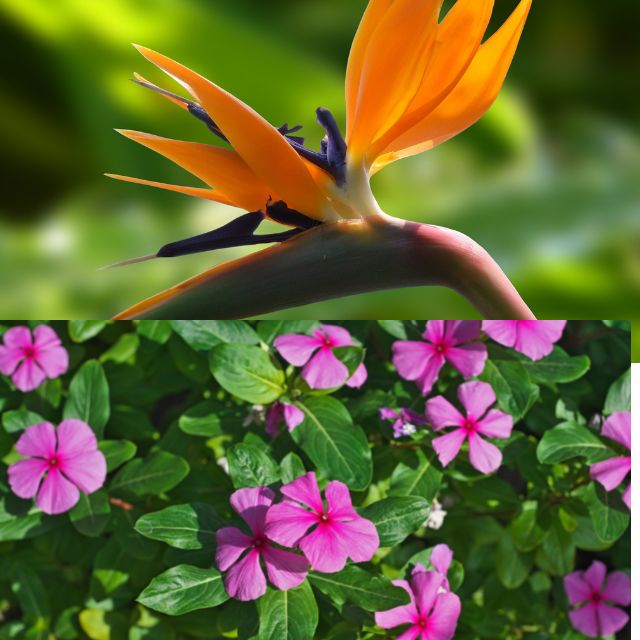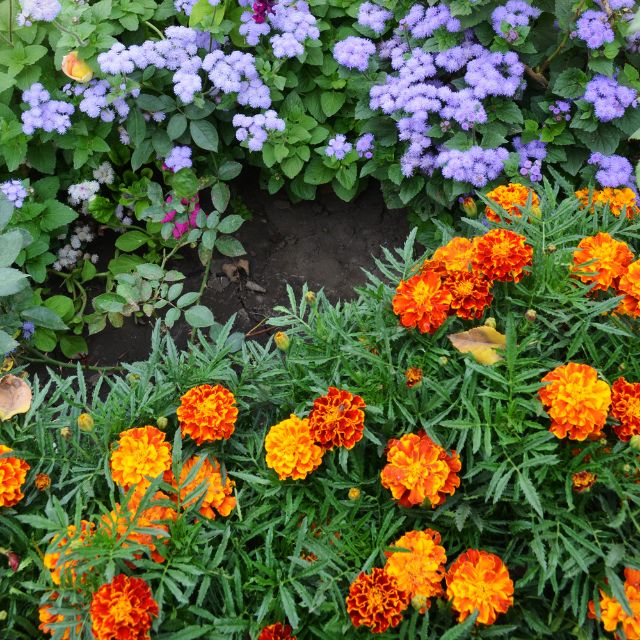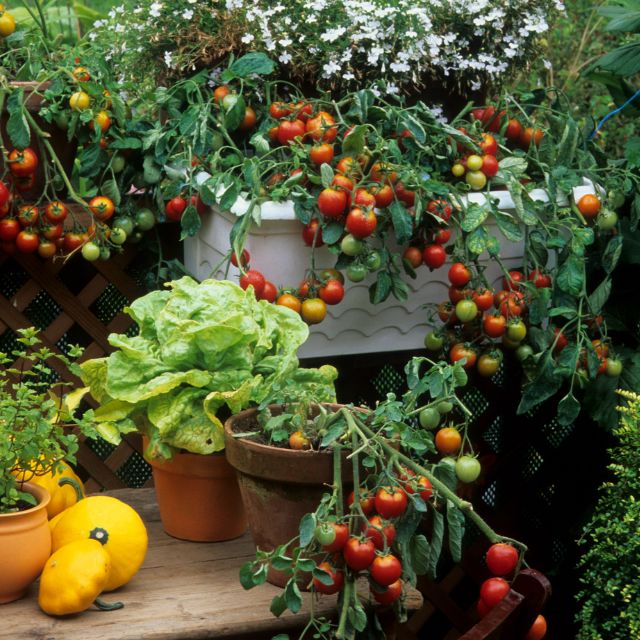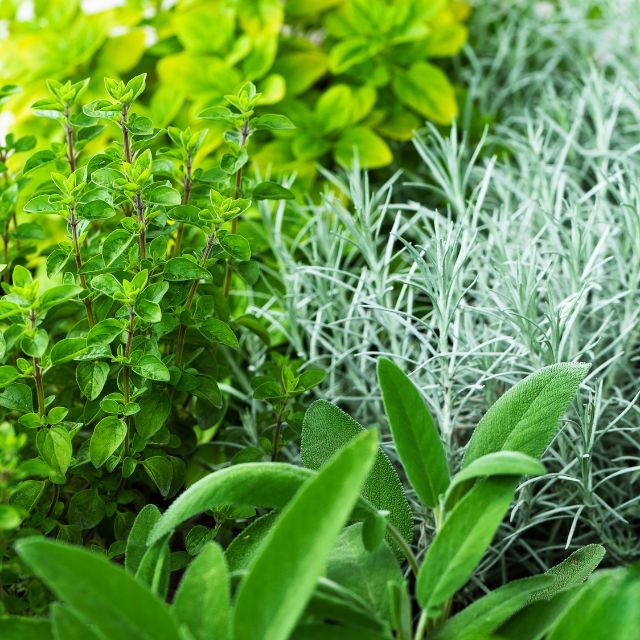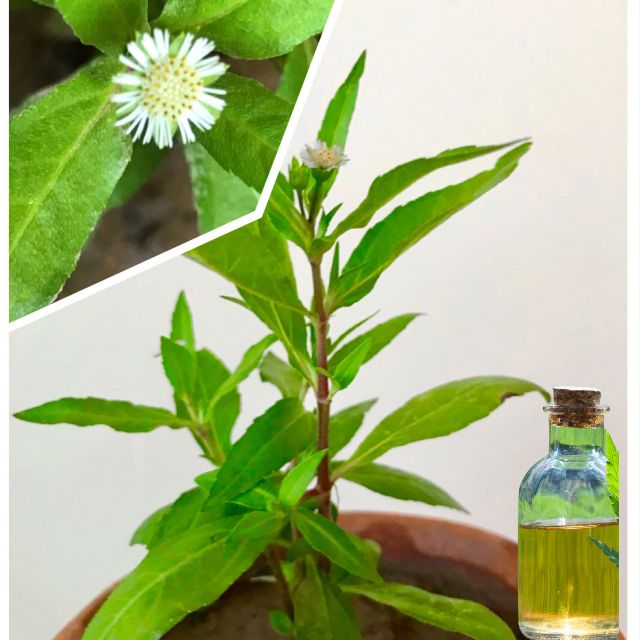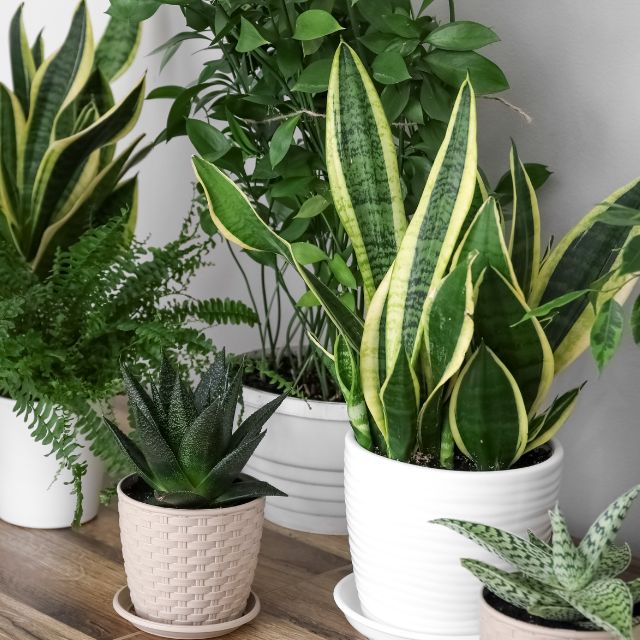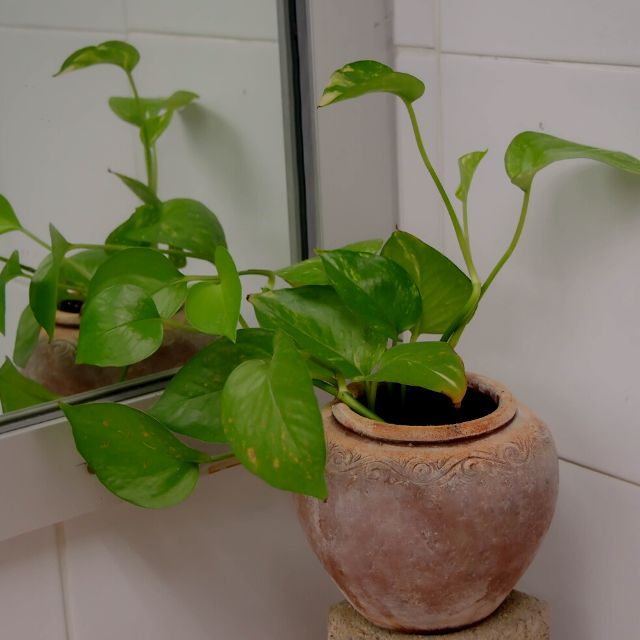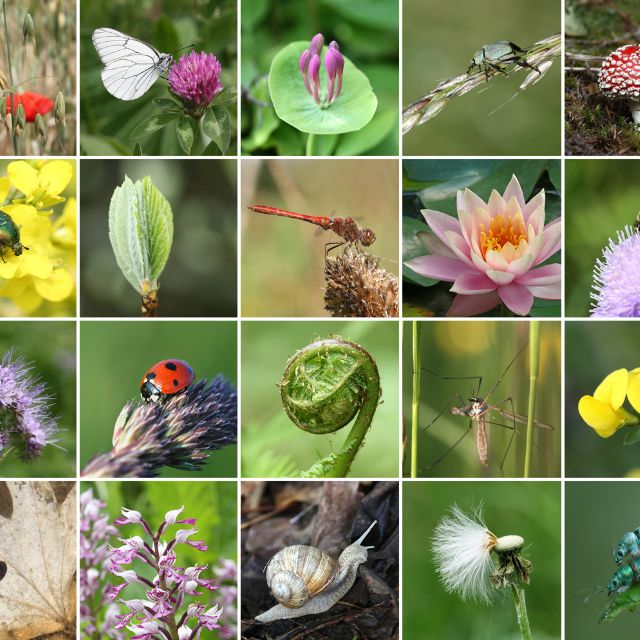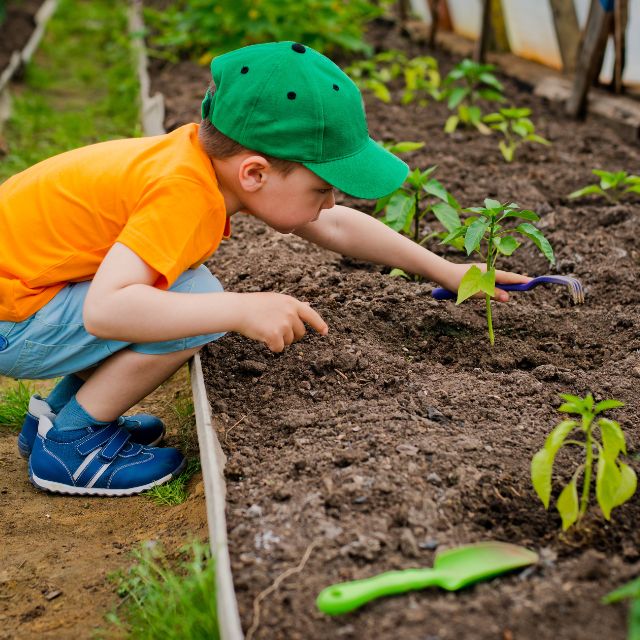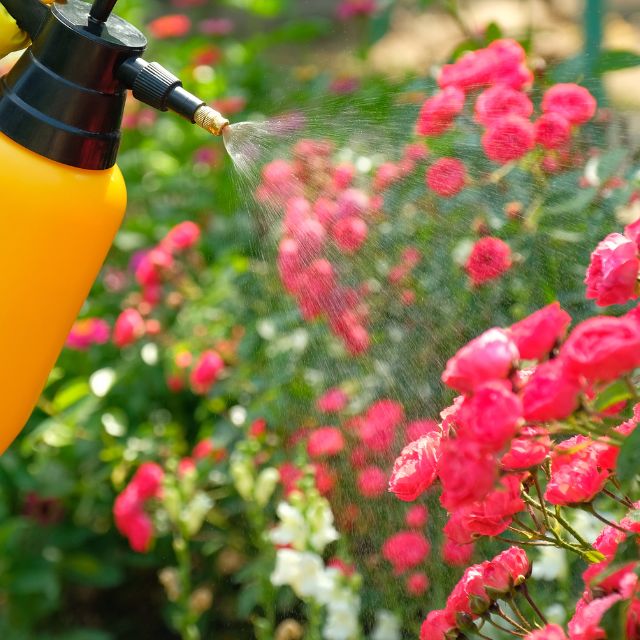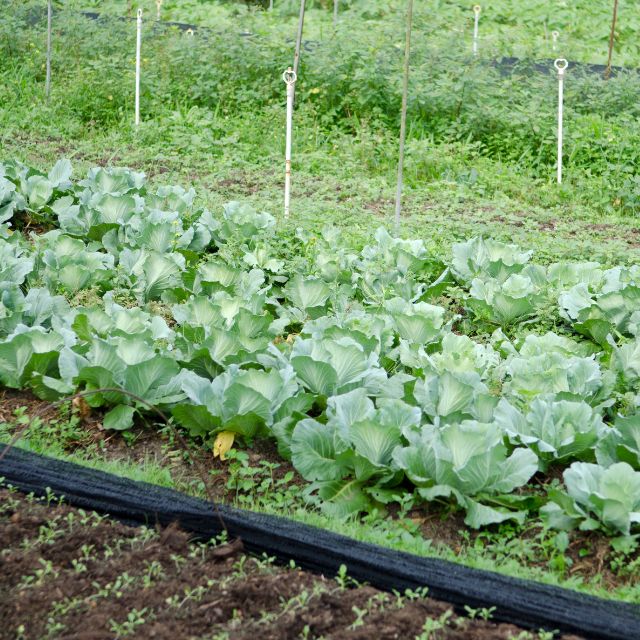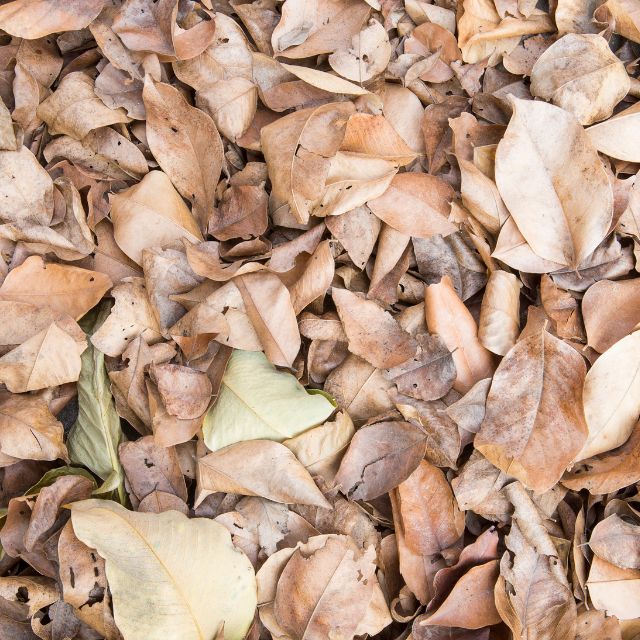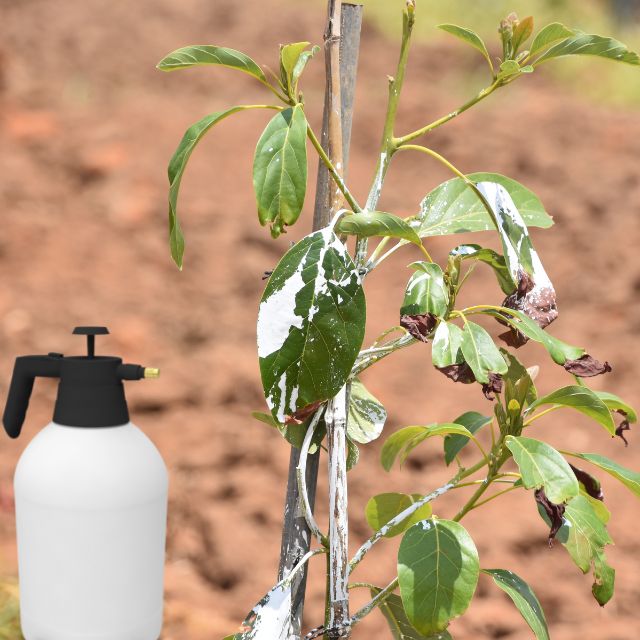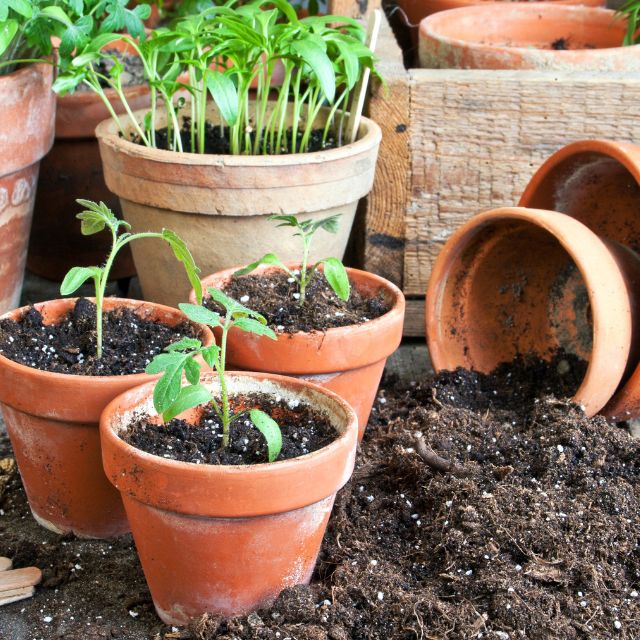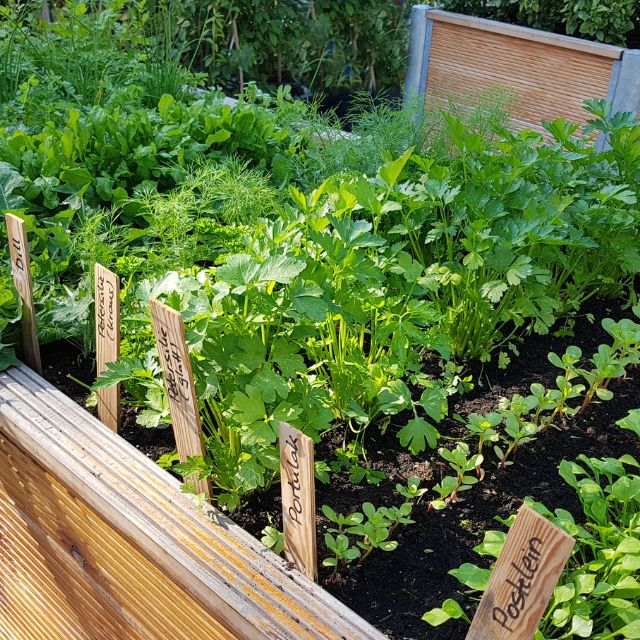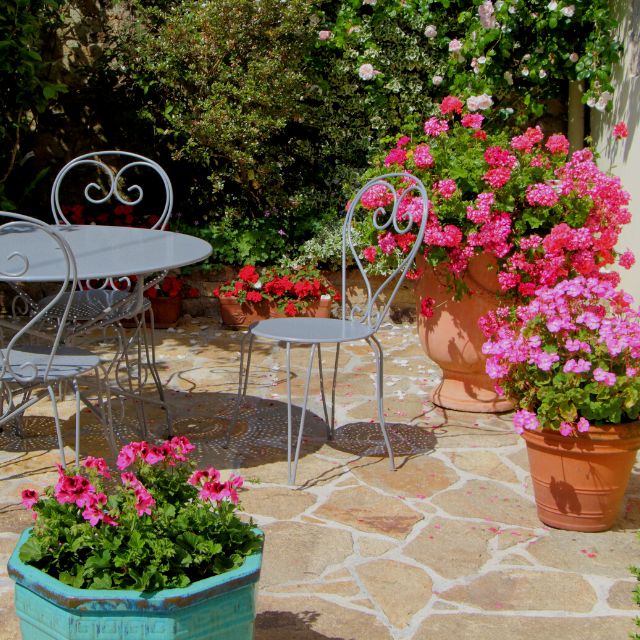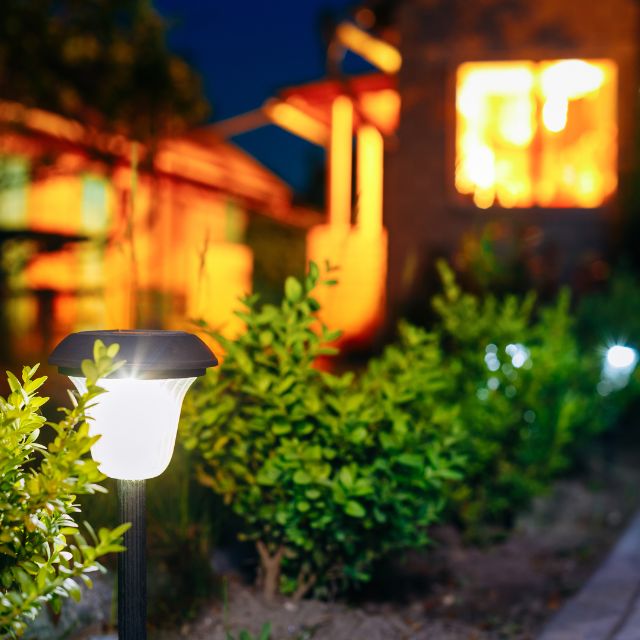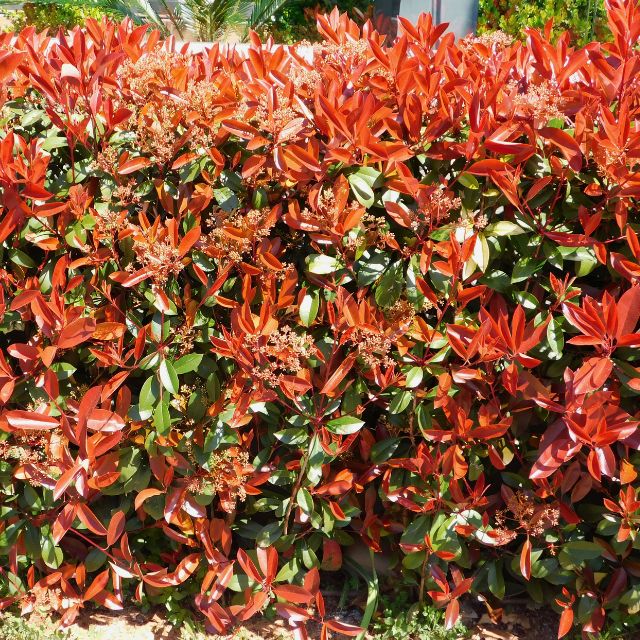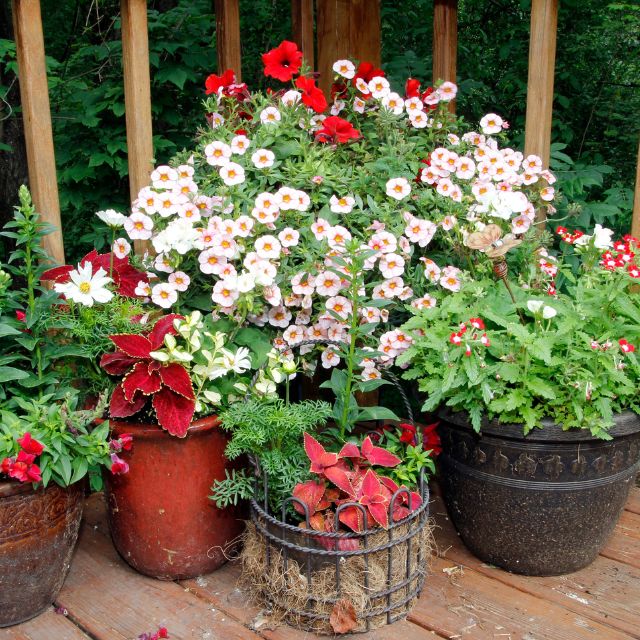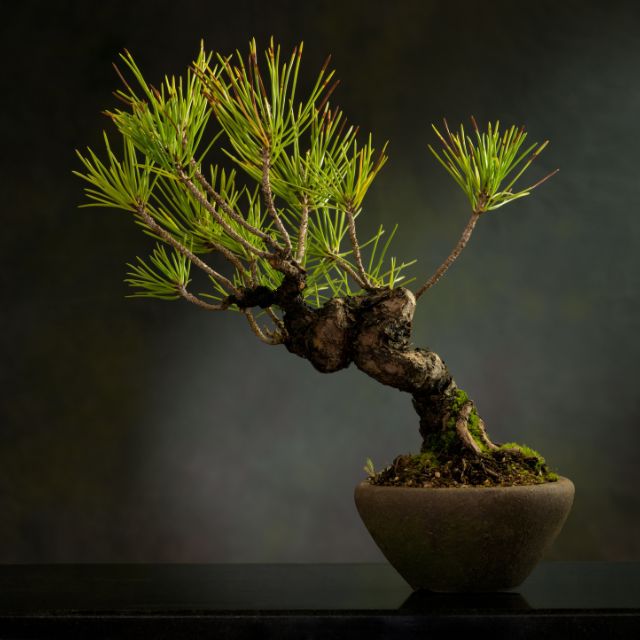#1: Introduction to Terrace Gardening
We are always looking for a spot of green in the concrete jungles we live in. In the past decade or so, there's been a rise in the number of urban homeowners starting terrace gardens. If you're a novice gardener, you might need some terrace garden ideas to create the terrace garden design of your dreams.
You can grow a terrace garden filled with flowers, vegetables, fruits, herbs, or a mix of all. If you're an enthusiast looking to get your hands dirty or even a pro-gardener, this ebook will help you advance your terrace gardening journey.
Gardening is Therapeutic
Gardening is much more than a hobby. There are many proven benefits of gardening that are important to us. It doesn't matter if you’re a hobby gardener or a professional-level landscape designer, spending time in the garden pottering around in the soil and caring for your plants is very valuable. Here are 10 reasons you should start a garden:
- Gardening can reduce anxiety: When you make time to go out and work in your garden, your anxiety levels can go down and you could start to feel less depressed. Gardening can improve self-esteem: You may not have been born with a green thumb, but after planting and nurturing your garden, you might see a person who can grow things and is in tune with the earth. Harvesting that 1st tomato is the best feeling ever!
- Gardening is good for your body: Digging, planting, and weeding can help burn some calories and strengthen your heart.
- Gardening can make you happy: Getting soil under your nails while digging in the ground can make you quite happy. In fact, inhaling M. vaccae, a healthy bacteria that live in soil, can increase levels of serotonin and reduce anxiety.
- Gardening can improve mobility: All the digging and planting do more than produce plants. Gardening increases hand strength and mobility.
- Gardening is great for bonding: Getting the entire family to tend to the garden together on the weekend, is a wonderful way to bond.
- Gardening encourages a nature-connect: Nature deficit disorder is an accepted disorder in behavior in humans due to lesser exposure to nature. Research has shown that being in more concrete environments with no plants/nature can increase stress, low problem-solving capacity, and poor communication
- Gardening can help save money: growing your own vegetable, greens, herbs, and fruit can help reduce market visits and help you save money
- Gardening can help you get healthier: Consuming your own, homegrown, zero-poison seasonal vegetables which are higher in nutrition is good for your health
- Gardening gives you a sense of purpose: Gardening is a way to care for something and nurture it from a tiny seed up to a large plant. This is enough to give us purpose and pride when the plants take root and grow.
- Gardening helps you sleep better: Spending time gardening has the pleasant side effect of tiring you. It also helps you clear your head of all of the anxious or stressful thoughts and this can help you fall asleep faster.
Benefits of Terrace Gardening
Terrace gardening is an ideal form of landscaping for homeowners who don't have much space to grow plants.
It doesn't matter whether you live in a city apartment or a suburban house, terrace gardening can give you plenty of fresh vegetables and herbs without taking up too much room.In addition to providing fresh produce, terrace gardens also offer a number of benefits. Here are 10 benefits of terrace gardening.
#1. Terrace Gardens Offer Space Savings
Terrace gardening allows you to maximize the amount of land available to you. Instead of growing plants on land, you can grow them in containers. This means you won't waste any valuable real estate.
#2. Terrace Gardens Provide Easy Access to Plants
With terrace gardening, you can access your plants at eye level without reaching down too much or being over.This makes it easier to tend to your plants and harvest fruits and veggies whenever you want.
#3. Terrace Gardens Reduce Water Use
Because terrace gardens allow you to grow plants in containers, you can water only how much is required. This reduces the amount of water used in watering your plants.
#4. Terrace Gardens Save Money
Growing your own vegetables, herbs and medicine in open sunlight with good yield helps reduce your dependency on markets for vegetables. Planning for a compost bin also helps in reducing the costs for purchasing manure.
#5. Terrace Gardens Help Prevent Pests
Pest infestation is one of the biggest problems facing urban dwellers. If you live in an area where pests such as ants, cockroaches, and termites are common, terrace gardening may be the perfect solution for you.By planting crops in raised beds, you prevent pests from entering your home. Plus, you can easily remove weeds and debris that attract insects.
#6. Terrace Gardens Create Beautiful Landscapes
Terraces give you the opportunity to create unique landscapes. By using raised beds, you can create interesting shapes and patterns in your garden.
#7. Terrace Gardens Increase Productivity
Raised beds allow you to grow multiple types of food simultaneously. For instance, you can grow tomatoes, peppers, cucumbers, and eggplants together.
This helps you cut back on wasted space and saves you money.
#8. Terrace Gardens Improve Air Quality
Planting trees and bushes on your terrace improves ambient oxygen. As a result, air quality improves for you and your family.
#9. Terrace Gardens Allow You to Grow Food All Year Long
Many people think that summer and winter are the best times to grow food. However, you can actually grow food all year round.
During winter, you can grow root vegetables such as carrots, turnips, radishes, beetroot, and potatoes. During summer, you can grow leafy greens such as lettuce, spinach, gourds, tomatoes, brinjals, etc.
These foods are nutritious and delicious. Plus, they taste great straight out of the garden.
Common myths and misconceptions about rooftop gardening
Terrace gardens are becoming increasingly popular. They provide an opportunity for homeowners to grow food without spending much money. However, many people still don't understand exactly what terrace gardens are and how they work.
Let me tell you about five common myths about terrace gardening.
Myth #1: Terraces are too small to grow plants
This myth is based on the misconception that terraces are too small to support a garden. This isn't true. Many homes have roofs that are larger than most backyards.
There are several factors that determine whether a terrace roof is suitable for growing food. First, the slope of the roof has to be gentle. If the slope is steep, water may run off the roof and cause damage to the house below. Second, the roof should have adequate ventilation. Third, the roof should be flat. If the roof slopes down towards one side, rainwater may collect and seep into the building. Fourth, the roof should be structurally sound. Lastly, the roof should be clean. Dirt and debris can prevent sunlight from reaching the plants.
Myth #2: Rooftops aren't safe places to grow food
Many people think that growing food on top of buildings is dangerous. While it is true that growing food on rooftops does pose certain risks, these risks are minimal compared to those posed by conventional farming methods. For example, pesticides used in conventional agriculture contaminate groundwater and soil. Growing food on rooftops doesn't pose any such threats.
Myth #3: Rooftops won't produce enough food
Some people believe that growing food on terraces won't yield enough food to feed a household. However, this is untrue. Most rooftop gardens produce between 50% and 100% of the vegetables needed by a household.
Myth #4: Rooftops cost too much to maintain
Growing food on terraces is often cheaper than buying groceries. Some studies show that growing food on terraces costs between Rs 500 and Rs 1000 per month. By comparison, grocery bills average over Rs 5000 per month.
So next time you see a terrace garden, remember that it's actually a very practical method of producing fresh food.
#2: Organic Gardening
There is so much buzz in the last few decades on “going organic”, “organic farming” and “organic gardening”. Its one of the best transitions to have happened from a society that was uitilising so much chemicals in everyday life.
What is Organic Gardening?
Organic gardening is “gardening without using synthetic products like chemical fertilizers and pesticides”. It involves the use of only natural products to grow plants in your garden. The natural products replenish natural resources as it uses them. It is the traditional way in which farmers managed their farms, before chemical agriculture.
We all want the food we serve to our families to be safe and healthy. An organic gardener ensures that their activities are in harmony with the ecosystem, minimizing exploitation as well as replenishing all the resources consumed by the garden.
There are three main objectives of organic gardening.
These are:
1. Soil management which is managed by using organic fertilizer;
2. Weed management which is managed by manual labor and use of organic ground covers
3. Pest control which is dealt with by promoting beneficial insects and companion planting
Organic gardening is simple and makes you a part of the nature around you.
Why go Organic?
If you have been dabbling with the thought of following an organic path, then we hope these top reasons will convince you to make the shift
- Chemicals are toxic: From respiratory problems to skin rashes and blisters, using chemicals affects your health. These chemicals can remain within the body and this can reflect as different forms of cancer and growth defects.
- Nutritious: Organic vegetable gardens produce yields that contain higher levels of important antioxidants, minerals, and vitamins that are good for you
- Combats climate change: Its found that the practice of organic farming would reduce emissions compared to conventional farming when it came to factors like livestock and crop production
- No pollution of water and soil: Since organic products are natural they dont cause any pollution
- Promote biodiversity: Chemicals deter butterflies, birds, bees and other fauna. But if you practice organic gardening, you will be mesmerized by the insects and birds that visit your garden
- Maintain healthy soil: Natural gardening practices like mulching, fertilisers and crop rotation, we build on the existing soil to make it more fertile
- Tastier food: Any food that you grow organically tastes a whole lot better than chemically grown food.
- Breathe easy: It's uncomfortable to walk into a garden that uses chemicals due to the choking smell. Organic gardens don't have that issue
How do to plan an organic garden?
If you've been thinking about planting an organic garden, here are some tips to help you plan an organic garden.
#1. Choose the Right Location
Before you decide to grow anything, you first need to determine whether you want to grow vegetables or flowers. Vegetables are easier to grow organically.
#2. Plant seasonal crops
If you live in a warm climate, you may want to grow tomatoes, peppers, cucumbers, squash, melons, eggplant, onions, garlic, lettuce, spinach, kale, broccoli, carrots, peas, strawberries, blueberries, raspberries, blackberries, and herbs.
If you live somewhere cold, you may want to plant radishes, potatoes, cabbage, cauliflower, Brussels sprouts, celery, leeks, parsley, chives, basil, oregano, thyme, rosemary, sage, mint, dill, and cilantro.
#4. Prepare the Soil Before Planting
Preparing the soil before planting helps prevent weeds and pests. This means clearing away any debris, adding compost, and leveling the area.
To prepare the soil, loosen up the soil to accommodate the root systems of each vegetable or flower.
Add fertilizer to the soil, then water thoroughly.
#5. Water the Garden Regularly
Watering is essential to keeping your garden thriving. Make sure to water deeply once every week, especially after heavy rains.Use a drip irrigation system if possible. Drip irrigation allows you to control exactly how much water goes to each plant.
#6. Fertilize the Garden
Fertilizing your garden regularly keeps your plants producing nutritious fruits and veggies. You can use farmyard manure, vermicompost, goat manure, or horsedung manure.
#7. Harvest Your Produce
Harvesting your produce is another key step in maintaining a successful organic garden.Pick vegetables when they're ripe. Don't wait until they wilt.Remove leaves and stems from your produce. These parts contain pesticides and herbicides.
#8. Maintain Your Organic Garden
Maintaining your organic garden requires regular attention.Keep up with watering and fertilizing your garden.Check your plants daily for signs of pest infestation.Clean out your pots and trays weekly.
#9. Enjoy Growing Your Own Food
Growing your own food gives you complete control over what you eat.It's healthier, cheaper, and tastier than buying store-bought foods.Plus, you save money by eating fresh, local produce instead of processed foods.
So go ahead and enjoy growing your own organic garden.
#3: Basics of Gardening
Sunlight
Plants usually get the light they need from the Sun. Plants use light energy to make a type of sugar called glucose, their energy source.
As part of the process of photosynthesis, plants make glucose in a part of their leaf cells called the chloroplast. Chlorophyll, the green pigment in chloroplast allows the plant to absorb light energy to create energy.
Different plants have different light requirements. Some need bright or direct light. Others can thrive in dimmer or indirect light. But NO plants can grow in darkness.
Flowering plants, vegetables, herbs and fruits love sunlight and would prefer anywhere between 6-8 hours of sunlight. Houseplants that are primarily foliage plants, can grow in conditions of 2-4 hours of diffused sunlight
Nutrition
Nutrients are substances that nourish a plant. In particular, plants need nitrogen, phosphorus and potassium. When dissolved in water, these nutrients get absorbed by a plant’s roots. If a plant can’t get the nutrients it needs from the soil, fertilizer need to be added.
Fertilizer provides plants with essential nutrients and helps them grow faster. Just like water, too much or too little fertiliser will impact the plants. A handful of manure or home made compost is hugely beneficial for the plant to provide N, P and K. The other micronutrients like calcium, magnesium etc
Water
Since gardens are a man-made creation, we cant completely depend on nature to take care of it. Watering is a regular activity to keep you garden healthy. Water is absorbed by the roots of the the plant. The main root is divided into subsidiary roots and root hairs. Water travels through a plant’s stems to the chloroplasts in the leaves. Plants need water for photosynthesis. Water also helps move nutrients from the soil into the plant. Too little water can cause a plant to wilt or droop. Too much water can cause a plant’s roots to rot. This is because the root hairs are able to absorb moisture and not water.
Stagnation of water around the roots have detrimental effects on plant health.
Site selection
Right plant and right place decisions is the most important decisions we make as gardeners because those choices can have the greatest impact on the success or failure of your garden.
A few of the important decisions to make regarding your garden are looking at the specifics of your terrace space.
Here are some important points to consider:
- It’s preferable if the terrace is open with ample sunlight. A shaded terrace may allow you to grow only shade plants along with ginger and turmeric.
- It’s important to have ample space. More space means more plants.
- Waterproofing is very important. Although the runoff from a container garden can be less, stagnant water may result in seepage.
- Is there proper drainage for water? Water should drain out and flow out of the terrace.
The answers to these points will determine the kind of garden you have and how well you can plan it for a luxurious garden.
Many home have terraces that are connected by a stair case so that there is ease of access for movement. If you are planning a terrace garden and your terrace is not accessible, you can plan to add a spiral staircase or a metal ladder which is sturdy to access the terrace space.
Plants need soil, manure and containers which generally end up being heavy items to move. Therefore, an accessible terrace is better to ensure that these heavy items can be moved without any trouble.
Additionally, after the garden is setup, regular watering, nutrient application, sowing and harvesting means regular interaction with the garden, so make sure that its easy to get in and out of your garden without any issues.
The terrace space should be your daily dose of positivity. So easy access is the best to make this space your personal zen garden.
#4: Soil
Gardeners often disregard the impact soil has on the health and vigor of their plants. Soil preparation isn’t the most thrilling aspect of planting a garden, but it’s certainly one of the most important. If your soil isn’t right, your garden will struggle to reach its full potential.
Start by digging up a scoop of soil and examining its texture in your hands. A garden is a reflection of the quality of its soil. Gardens filled with beautiful soil have a vitality about them that we can almost feel.
Achieving that vitality requires understanding the chemistry and composition of your soil and creating the perfect environment for fertile plant growth. Good soil management is a continual process, but once you attend to the basics, your soil will do most of the work itself.
Understanding soil types
On the basis of origin, colour, composition and location, the soils of India have been classified into: (i) Alluvial soils (ii) Black soils (iii) Red soils (iv) Laterite soils (v) Arid soils (vi) Saline soils (vii) Peaty soils (viii) Forest soils.
Alluvial Soil: Found in the Northern Plains of India and river valleys. The texture of these soils vary from sandy to clayey. High in potassium but poor in phosphorus. The colour of the alluvial soils varies from the light grey to ash grey. Alluvial soils are intensively used for cultivation.
Black Soil: Black soil covers most of the Deccan Plateau. The black soils are generally clayey, deep and impermeable. They swell and become sticky when wet and shrink when dried. Because of this character of slow absorption and slow loss of moisture, the black soil retains the moisture for a very long time, which helps rain-fed crops, sustain even during the dry season. Chemically, the black soils are rich in lime, iron, magnesia and alumina. They also contain potash. But they lack in phosphorous, nitrogen and organic matter. The colour of the soil ranges from deep black to grey.
Red soil: Red soil is foun along the eastern and southern part of the Deccan plateau. The soil develops a reddish colour due to a wide diffusion of iron in crystalline and metamorphic rocks.The fine-grained red soils are normally fertile, whereas coarse-grained soils found in dry upland areas are poor in fertility and lack nitrogen, phosphorous and humus.
Laterite Soil: The laterite soils develop in areas with high temperature and high rainfall. These are the result of intense leaching due to tropical rains. These soils are poor in organic matter, nitrogen, phosphate and calcium, while iron oxide and potash are in excess. Hence, laterites are not suitable for cultivation; however, application of manures and fertilisers are required for making the soils fertile for cultivation.
Arid soil: Arid soils range from red to brown in colour. They are generally sandy in structure and saline in nature.They lack moisture and humus. Nitrogen is insufficient and the phosphate content is normal. These soils are poor and contain little humus and organic matter.
Saline Soil: . Saline soils contain a larger proportion of sodium, potassium and magnesium, and thus, they are infertile, and do not support any vegetative growth.
Peaty Soil: They are found in the areas of heavy rainfall and high humidity, where there is a good growth of vegetation. Thus, large quantity of dead organic matter accumulates in these areas, and this gives a rich humus and organic content to the soil.
Forest Soil: forest soils are formed in the forest areas where sufficient rainfall is available. The soils vary in structure and texture depending on the mountain environment where they are formed. Lower elevation forest soils are more fertile than high elevation.
Science of Soil
Soil is the most important factor that supports all terrestrial life. It is what supports trees, grasses, crops, and so many other organisms on the earths surface. The bulk of our food and much of our clothing is derived from land-based crops that grow in the soil. This soil on which we depend so much has evolved over thousands of years by the various agents of weathering and gradation have acted upon the parent rock material to produce a thin layer of soil.
Soil is a complex mixture of inorganic materials derived from erosion of rocks and organic matter or humus, the decomposed remains of plants and animaThe actual amount of each of these depend upon the type of soil. Sand, loam and clay are important elements of soil that determine its texture and porosity. Water-holding capacity is defined as the water content of a thoroughly wetted soil after surplus water has drained out by gravity. Sandy soils retain less water, whereas the addition of humus increases the water holding capacity, the moisture being held in the small spaces. Clayey soil on the other hand stick to water and make a sticky tight mix that even roots are unable to break. It therefore doesnt aid in root respiration and gaseous exchange.
Soils can also be determined based on their pH. Soils are acidic or alkaline ranging with pH from 1-14. The neutral pH of 7 is most preferable for plants while, some plant like acidic and alkaline media. Plant media (Soil+Nutrition) is made up of macro and micro nutrients. Macronutrients are those used in greatest quantities by plants. Micronutrients are used in lesser amounts, but vital for a plants growth.
|
Macronutrients |
Carbo, Hydrogen, Oxygen, Nitrogen, Phosphorus, Potassium, Sulpher and Calcium |
|
Micronutrients |
Magnesium, Iron, Copper, Zinc, Manganese, Molybdenum and Boron |
Whichever part of the world you live in, it is always better to use the soil that is most locally available to you. Any soil can be enhanced by adding nutrition to enhance the macronutrients of N, P and K. This can be manure or home made compost.
What is the best soil for your garden
Unless you live in a completely undeveloped area, native soil is probably not a large part of your landscape, and you are stuck with what you have.
The good news is that gardening science has shown us what the ideal soil looks like: a combination of clay, sand, and silt, with a bit of organic matter. We know that pore space within soil is critical for retaining both water and oxygen and that compaction is primarily to blame for lifeless soil and struggling plants. We have easy tests to determine soil texture and pH, and university and government labs can provide us with additional information about nutrient levels, organic matter content, and possible contamination. Armed with this knowledge, it’s possible to turn nearly any soil into great soil.
Remember, N, P, K needs to be provided in the nutrition that you provide which is available in manure or home compost.
Additional to soil itself, an addition of cocopeat and sand are very important to enable drainage and aeration in the soil.
Fungi and fungal networks in garden plants
In nature, fungi play an essential role in decomposition processes. They break down dead organic matter and recycle nutrients back into the ecosystem. Fungi are also involved in the formation of soil structure and contribute to nutrient cycling.
They also provide food for animals such as birds, insects, and mammals.
However, most people don't realize that fungi are present in our gardens and yards.
This article discusses the importance of understanding these organisms and their roles in the environment.
What are Fungi?
Fungi are eukaryotic microorganisms that lack cell walls. This means they cannot reproduce sexually and therefore produce spores instead. Spores are small, single-celled structures that contain DNA and can survive anywhere in the world.
Fungi are classified according to their shape and size. There are two types of fungi: filamentous and yeasts. Filamentous fungi include mushrooms, truffles, and puffballs. Yeast fungi include baker's yeast, brewer's yeast, and wine yeast.
Functions of Fungi
Fungi perform several functions in the environment. These include breaking down dead organic matter, recycling nutrients, forming soil structure, providing food for animals, and protecting plants against pathogens.
Decomposing Dead Organic Matter
Fungi decompose dead organic matter. Decomposition involves breaking down complex molecules into simpler ones.
For example, cellulose is composed of sugar units joined together by glycosidic bonds. Cellulase enzymes break down cellulose into glucose.
Recycling Nutrients
When fungi decompose dead organic matter, they release nutrients back into the environment.
Nutrient recycling helps maintain the health of ecosystems.
Forming Soil Structure
Some fungi form soil structure. Soil structure refers to the arrangement of particles within the soil.
Soil structure affects water infiltration, air permeability, and drainage.
Protecting Plants Against Pathogens
Plants protect themselves against pathogens using physical barriers and chemical defenses.
Chemical Defenses
Plant chemicals defend against pathogens. Plant chemicals include phenolics, alkaloids, terpenoids, glucosinolates, and cyanogenic compounds.
#5: Manure
Plant nutrition
Nutrition is one of the important elements of our garden. Regular addition of nutrition to our garden helps to give plants good health and vitality to be able to fight against pest and fungal infections. Just like us, when we eat bad food or irregular meals, we tend to lose immunity and fall sick. Same with plants, when it lacks important nutrients from the plant media, it loses immunity and tends to get infected easily.
Strictly speaking, the essential elements are those that plants require to complete their life cycle. This chemical collection is constantly changing as we learn more about plant biochemistry.
Most manure contributes nitrogen, phosphorus and potassium. These important nutrients contribute to healthy plants and play a role in different parts of a plant life cycle - growth, reproduction and new progeny.
Stages of growth
Nitrogen is always given importance because it's what keeps plants green and healthy above ground. Nitrogen is incorporated into the structure of chlorophyll and proteins. Proteins construct cell membranes, build genetic matter and enzymes all of which are vital for growth. It helps in production of new shoots and overall plant growth. Plants lacking nitrogen tend to show yellowing of the leaf and also are stunted.
Phosphorus builds healthy roots, therefore prominent as a nutrient for below ground growth. It also promotes fruiting and flowering. They are a vital component of phospholipids, which help in transporting materials through the plant body and maintaining structure.
Potassium is important for overall plant health. Potassium is associated with the movement of water, nutrients and carbohydrates in plant tissue and to build strong cells which helps the plant deal with stresses of changing temperatures and disease. If K is deficient or not supplied in adequate amounts, it stunts plant growth and reduces yield. It also improves disease resistance and general plant health.
What is manure
Manure is one of the most useful things in nature. Manure has been used since ancient times to improve soil fertility and crop production. Today, manure is still widely used to fertilize crops and livestock feed.
There are two types of manure: organic and conventional. Organic manure is produced without using any chemical fertilizer or synthetic pesticides. Conventional manure is made from animal waste products such as urine, feces, and bedding materials.
Organic manure is considered to be an excellent source of nitrogen, phosphorus, potassium, calcium, magnesium, sulfur, and trace elements. However, conventional manure is usually rich in nitrogen, phosphorous, and potassium.
In addition, organic manure is generally richer in humus content than conventional manure. Humus is a form of carbon that helps plants absorb water and nutrients.
Humus is also known as black gold. It is formed when organic matter decomposes under certain conditions. This process is called composting. Composting is a natural phenomenon that occurs whenever organic material decays.
Types of manure
Farmyard manure refers to the decomposed mixture of dung and urine of farm animals along with litter and left over material from roughages or fodder fed to the cattle. On an average well decomposed farmyard manure contains 0.5 per cent N, 0.2 % P2O5 and .0.5 % K2O.
Sheep and Goat Manure: The droppings of sheep and goats contain higher nutrients than farmyard manure and compost. On an average, the manure contains 3 per cent N, 1 per cent P2O5 and 2 % K2O.
Oil cakes
After oil is extracted from oilseeds, the remaining solid portion is dried as cake which can, be used as manure. The oil cakes are of two types:
- Edible oil cakes which can be safely fed to livestock; e.g.: Groundnut cake, Coconut cake etc.
- Non edible oil cakes which are not fit for feeding livestock; e.g.: Castor cake, Neem cake, Mahua cake etc.,
Both edible and non-edible oil cakes can be used as manures. However, edible oil cakes are fed to cattle and non-edible oil cakes are used as manures especially for horticultural crops. Nutrients present in oil cakes, after mineralization, are made available to crops 7 to 10 days after application. Oilcakes need to be well powdered before application for even distribution and quicker decomposition.
Green manuring can be defined as a practice of ploughing or turning into the soil undecomposed green plant tissues for improving physical structure as well as soil fertility. Green manuring, wherever feasible, is the principal supplementary means of adding organic matter to the soil. The green-manure crop supplies organic matter as well as additional nitrogen, particularly if it is a legume crop, due to its ability to fix nitrogen from the air with the help of its root nodule bacteria. The green-manure crops also exercise a protective action against erosion and leaching. Green manure to be incorporated in soil before flowering stage because they are grown for their green leafy material, which is high in nutrients and protects the soil. Green manures will not break down in to the soil so quickly, but gradually, add some nutrients to the soil for the next crop.
Leaf Compost Leaf composting, can be achieved by heap or ditch composting or by windrow composting. Windows are preferred as they allow efficient handling of materials. Provide good aeration, allow efficient absorption of water and are easy to be formed.
Making your own compost
Making your own compost
If you are a beginner to composting, start off with the most popular method: aerobic composting in a pot. Aerobic composting is done above-ground with the help of microorganisms that consume and decompose organic waste matter in an aerated environment. You can make the composting container yourself or buy one. Usually, three pots are used, stacked one on top of the other.
Here are the steps involved:
- Segregate your household waste into dry and wet—right in your kitchen. Fruit peels, teabags and leftovers of food are wet waste, while paper, plastic and packaging are dry waste.
- Put the wet and dry waste in two different containers in the kitchen.
- Once the wet waste container is full, put its contents into the first compost pot.
- Add dried leaves of the same quantity as the waste.
- Add semi-composted material, buttermilk or cow dung to start off the decomposition process.
- Turn the pile around every other day.
- The pile has to be kept at the right level of dampness. If it is too wet, add dried leaves and stir. If it is too dry, add water and stir.
- Once full, leave the pot open for 30–45 days for the composting to happen.
- Once the container is full, move the semi-composted matter into a larger container or bin.
- After two months, the waste will turn into rich compost that can be used or sold as manure.
Note: Do not add cooked food, meat and dairy products, at least in the beginning, to avoid a stench.
Like any other initiative, it will take you a couple of months to familiarize yourself with the composting process. Initial problems like too many maggots, soldier flies, fruit flies or the stench might put you off, but stay on course and complete at least two cycles of composting. Not only will you be reducing the waste generated in your city, but also contributing to an environment-conscious society.
Other Soil amendments
Jeevamrutham - is an important liquid fertiliser which helps with the regular dose of nitrogen to the plants. It consists of a rich mix of microorganisms. Jeevamrutham is the rich source of the beneficial microorganism such as nitrogen fixing and phosphate solubilizing bacteria. Jeevamrutham is efficiently used between 8th and 12th days of preparation. Addition of such organic liquid manure would help to improve efficient microbial consortia thereby increasing NPK content and plant growth promoting factors. Jeevamrutham hastens the natural functions of the soil there by increasing the growth rate of plants and their yield. Earthworm, inevitable to the fertility of soil moves up towards the top as a result of this. The elements in the excreta of earth worm, is broken down into molecular form by the microbes in the jeevamrutham, so that, it can be easily absorbed by the roots. These microbes disintegrates wastes in the soil there by making soil more fertile. The upward and downward movement of the worms loosens up the soil. This creates a positive environment for the growth of the plants. It also helps plants to absorb nutrients from the soil.
Preparation of jeevamrutha
List of ingredients
- Cow dung (native cow’s) - 10 kgs
- Cow Urine (native cows) - 10 litres
- Jaggery – 1 kg
- Gram Flour - 1 kg
- Local soil – 1 handful
- Water free of chlorine – 200 litres
Take a big plastic barrel and fill it up with cow dung, cow urine, jaggery, flour and soil. Mix them well. Cover the barrel with a sack. Using a piece of log, stir in a clockwise direction daily. Since it is under fermentation, carbon monoxide, carbon dioxide, ammonia and methane are produced. The sack allows these gases to escape. It will be ready to use in 2 days if it is summer, or 3 days in winter. The jeevamrutham produced should be used up in 5 days.
Jeevamrutham is a store house of microbes. This shall not be empties into the roots. Instead, pour this mix into the shade of the plant at 12 pm when the sun is out. Mulching The ground where jeevamrutham has been added is compulsory. This retains the moisture in the soil. It also increases microbial activities in the soil. Depending upon the availability of jeevamrutham, 200 litres per acre of land can be used twice or thrice in a month. This can be missed in water used for irrigation also. In sprinkle and drip irrigation system, introduce a tube into the main water pipe and add well strained jeevamrutham through this tube.
- Neem cake
- Neem cake is another very important soil amendment in gardening
- It is made by crushing neem leaves, bark and fruit
- They have high levels of N, P, & K that make them perfect for plants
- It is best when it is mixed with other fertilisers, as it acts as a slow-release fertiliser, which means that it regularly releases nutrients than in a single shot
- To used if for your garden, about 100 grams can be sprinkled on the top soil of your garden once a month
- The dual activity of neem cake being a fertiliser and pesticide helps many gardeners and farmers in having healthy plants. It particularly helps with soil pests like nematodes and white ants
- It is one of the ways to prevent pest attack on lawns. Soak 1 kg of neem cake and honge cake in half a bucket of water and sprinkle on the plants
- Pongam cake
- Pongamiaa multipurpose leguminous tree containing non-edible oil grows widely in India.
- Oil extracted from the seeds of Pongamia is used as energy source as well as in tanneries while the cake (a by-product after extracting oil) was found to be rich in all plant nutrients in general and nitrogen (4.28%) and sulphur (0.19%) in particular.
- Use of Pongamia cake has Table 7- Grain yield of soybean as influenced with sources of nitrogen provided essential plant nutrients for crop production in addition to organic carbon content
- Citrus Bioenzyme
- Bioenzyme is a multipurpose product that is produced by fermentation of fruit or vegetable peels where anaerobic microbes decompose organic matter in absence of oxygen.
- Commonly, bio enzymes are used for cleaning purposes and as pesticide or fertilizer for plants. It is 100% organic and safe to use.
- The natural properties of citrus bioenzyme make it suitable as a biopesticide and fertilizer which can be used as foliar spray.
- Bioenzyme if particularly beneficial for encouraging flowering and fruiting in plants
- Bioenzyme Preparation
- Ingredients: Jaggery, citrus peels, water, pinch of yeast
- Apparatus: plastic or glass container
- Process:
- Fill the container with jaggery, citrus peels and water in 1:3:10 ratio by weight and close tightly
- Open the container once a week to let out the gas
- The process completes when the peels settle at the bottom of the container
- Strain out the liquid part and store it to use as a foliar spray
- Duration:
- 21 days with the addition of yeast, if not 2 months
- Peels of any fruit or vegetable can be used to make bioenzyme but citrus peels are most suited for cleaning purposes.
- The sugars in jaggery help to produce anaerobic microbes which feast on the sugar and break down the peels to produce an enzyme.
- The acidity can be adjusted to a comfortable level by diluting with water, so that it is not too concentrated for your needs and you do not end up consuming all of it too quickly till the next batch is ready.
- Banana Bioenzyme
- Making homemade organic liquid fertilizer is surprisingly easy to do, and it only uses three ingredients: water, over-ripe bananas, and brown sugar.
- Bananas and their peel contain many micronutrients, including nitrogen, phosphorus, and potassium.
- This can result in roses and other flowering plants producing more prominent, more beautiful blooms when they absorb this fertilizer.
- Slice the overripe bananas fruit into small circle-shaped pieces
- Place the cut bananas into a bowl
- Sprinkle the organic jaggery over the bananas and mix them well
- Put the mixture into an airtight container. Place a cloth or paper towel covering the top of the container for added air-tightness
- Close the lid of the container very tight to prevent ants or flies from entering
- Leave the container at room temperature for 21 days.
- After 21 days, the liquid formed can be diluted. Add 10 ml of enzyme to 1 litre of water and spray on the plants, especially those that are not flowering, or about to flower
#6: Containers
- Contrary to common belief, you need not have acres of open land to grow a beautiful garden – whether this is of flowers or edibles.
- You can very well do it in containers. All you have to do is consider each container as a small plot private to each plant. With the help of containers you can build a most beautiful and useful garden within your home or outside.
- The plus point here is that anyone can make a great container garden.
- This is the best project for a novice who wants to grow green fingers. The fact that this can be done in the smallest possible places adds to the excitement. It does not matter whether you have too much sun or too less – there are enough plants that you could use to match your conditions.
- Container gardening is just a portable garden
Types of containers
You can choose any type of container when you plan to start your “garden in a pot”. There are plenty of choices for containers – you have plastic, terracotta, concrete, wood, ceramic, and even metal. The newage containers are Fibre-reinforced-plastic of FRP. They look like ceramic, but are light and Be careful however, that you do not use any pot that once contained any type of poisonous or toxic material; especially if you are planning to grow something edible.
- Concrete Planters:
-
- Concrete planters are hardy and strong
- At a base layer, they are grey in colour, but it can be painted over in any other colour
- They material is quite dense, and sometimes does not allow for enough porosity for water to get evaporated
- The planters are very heavy, and moving it around is a little hard, especially if it is filled with wet soil
- If the concrete chips, it's easy to fix, and therefore long-lasting
- Shapes vary from rectangular, circular and square. Any shape can be created is a mould is available
-
Metal Planters:
- Metal pots are cheap and light.
- The drainage hole is important, as the material prevents the evaporation of material
- They can be painted over with any colour and usually available in multiple colours
- Railing and hanging planters are the usually available options
- The planters are lightweight and easy to move around and store, when the planter gets changed.
- The one problem with metal planters is that they may start rusting over time with continuous water exposure
- Terracotta planters:
-
- Terracotta planters are made of red mud which is baked and mould into planters
- The material is very porous and allows for water to get absorbed through the pores
- This is great for the excessive water to move out from the root zone, but if the terracotta planters are kept on a bright, hot sunlight space without planters around, the soil can get dry soon
- The planters are not too strong and sometimes a strong movement can result in the planter breaking
- Nevertheless, terracotta planters are more natural and great for your plants
- Wooden pots:
-
- This isn't very popular in india because it hard to get strong, treated wood in india
- Wooden planters tend to start rotting within a few months because of constant water in the planters
- Wooden planters can be lined with tarpaulin or a water-proof sheet to prevent water exposure
- Wooden planters look great and give you garden a very natural, earthy
- Fibre-reinforced Plastic (FRP) planters
-
- FRP are new age planters that can be found in contemporary and traditional designs
- Fibre-reinforced plastic is a composite material made of a polymer matrix reinforced with fibres.
- The fibres are normally glass, carbon or basalt. Each fibre brings in its characteristics based on the intended use of the final FRP planter.
- FRPs are commonly used in the aerospace, automotive, marine, landscape and construction industries.
- FRP planters are cheaper than ceramic planters.
- Used commonly in hotels and offices.
- Recycled containers
-
- Any container can potentially become a planter, if it can hold plant media and a drainage hole can be created.
- It is a great way to reuse and upcycle containers you would otherwise be recycling
- Old buckets, mugs, bottles, boxes, suitcases and even an old car can become a container garden. Its up to your imagination.
- You can colour it, all interesting addition, hang it or place it on the ground and convert your garden into a beautiful space, by not investing too much on buying containers
- Grow your flowers, or even vegetables in a recycled container garden
Important aspects of container gardening
- Keep in mind that it's easier to grow plants in large containers than small ones. That's because large containers hold more soil, which stays moist longer and resists rapid temperature fluctuations.
- Small planters are prone to drying out, and during hot summer weather, you may have to water them twice a day to keep plants alive.
- Several factors help determine how large and deep the container must be.
- Consider the size and shape of a plant's root system; whether it is a perennial, annual, or shrub; and how rapidly it grows. Rootbound plants, which have filled up every square inch of the soil available, dry out rapidly and won't grow well.
- Choose a large pot or tub for a mixed planting, one that will offer enough root space for all the plants you want to grow.
- Light-colored containers keep the soil cooler than dark containers.
- The maximum size (and weight) of a container is limited by how much room you have, what will support it, and whether or not you plan to move it.
- If your container garden is located on a balcony or deck, be sure to check how much weight the structure will safely hold.
- Containers range from small one which are 4-9 inches in diameter, which are good for succulents, seasonal flowers, some herbs and greens
- Containers that are 9-14” inches in diameter are considered medium. These are great for almost all greens, vegetable, herbs, and flowers
- Containers that are 16” - 2’ in diameter are great for growing small flowering and fruit trees as well as climbers.
Recycled container garden
There’s literally no end to the uses of different containers in your recycled garden. For instance, egg cartons can be used to sprout your seedlings, tin cans are great as recycled garden pots, used kitchen cleaner spray-bottles and a little neem oil make perfect pest control devices, while plastic fruit crates and even shopping baskets can be used as highly efficient garden riddles to remove the lumps from your compost. PET bottles are the most commonly used kinds of recycled gardens. Old suitcases, chest of drawers, old tires and even a old commode can be used to create a garden.
Cardboard can be used as a weed suppressor when placed carefully around your saplings and delicate plants, eventually decomposing right into the ground. And, don’t forget about those difficult-to-recycle Tetrapaks—they make for ideal little bird shelters or bug hotels, helping you to encourage diversity in your recycled garden.
In truth, there are infinite recycled garden ideas out there, and with just a little imagination you can build, landscape, and grow everything you need while still contributing to a more circular model of consumption. Remember, with a little creativity, what’s considered waste can be the next piece of spectacular recycled garden furniture or useful garden tool!
#7: Gardening Tools
- It’s easy to go overboard when purchasing gardening tools. They can take up a lot of space and cost money, but staying focused on the basics can keep your storage area from becoming overcrowded.
- Here are essential garden tools to get you going on any garden project
- Hand pruners, also called secateurs, help reign in plants that are getting out of control and taking over. Anvil pruners are best for dead wood and can cause crush injuries to fresh, green stems and branches. Bypass pruners are better for live plants and green wood.Pruners should fit easily in the palm of your hand. For cleaner cuts and less injury to plants, pruners should be sharpened regularly.
- Garden fork: An efficient tool for turning soil, garden forks can dig into dense soil better than a spade. Forks with a slight curve to the spines are useful for scooping mulch or turning compost piles.
- Hand spade: These short-handled square shovels are garden workhorses. They make easy work of digging holes for plants, edging, lifting grass clumps, and moving small bits of soil from one area to another. A good spade will last you the rest of your gardening life.
- Hand Rake: When leaves and debris fall, your rake is there to remove or move them around. Rakes come in a wide variety of styles and sizes, but a great starter is a standard leaf rake.
- Watering can: If you dont have a hose, a watering can with a shower head is great for your plants.
- Hose Pipe: For the terrace garden, a hose with a water connection will be the most apt setup to ensure easy watering of plants without the hassle of carrying multiple buckets. It would be worth it, if you want the exercise.
#8: Plant selection
When it comes to gardening, most people just throw whatever seeds they find lying around in their yard onto their soil. But not everyone has the same amount of space, and not every seed will thrive in every type of soil.
There are many factors that go into choosing the perfect plants for your garden. Learn how to choose the best plants for your garden based on your available space, climate, and soil conditions.
Native vs Non-native plants
- Native plants are adapted to the local climate and soil conditions where they naturally occur.
- These important plant species provide nectar, pollen, and seeds that serve as food for native butterflies, insects, birds and other animals.
- Unlike natives, common horticultural plants do not provide energetic rewards for their visitors and often require insect pest control to survive.
Native plants are also advantageous, because:
- Native plants do not require fertilizers and require fewer pesticides than lawns.
- Native plants require less water than lawns and help prevent erosion.
- Native plants provide shelter and food for wildlife.
- Native plants promote biodiversity and stewardship of our natural heritage.
- Native plants are beautiful and increase scenic values!
- Healthy spaces for people
Unfortunately, most of the landscaping plants available in nurseries are alien species from other countries.
These exotic plants not only sever the food web, but many have become invasive pests, outcompeting native species and degrading habitat in remaining natural areas.
Flowering Plants
Starting a flower garden is both fun and rewarding. If you love to fill up your garden with different species of flowering and ornamental plants, there are a few things to keep in mind before getting started:
- Create Unity: Use colours that blend together. According to popular landscape plant palettes red-yellow-orange colours go well and blue-purple-white colours blend well. Also referred to as energetic colours and calming colours.
- Create excitement: You can plan a brightly corner of your garden, which can have lots of flowering plants and some colourful containers
- Create calmness: Based on how much light gets into your terrace, another part of the garden can be mostly foliage plants and maybe a little bit of white to create a very peaceful and relaxed environment
- When designing a garden you should plan not only colour, but texture, form and height of the plants. Having a mix of large and small leaved plants with a background of a tall plant creates highlight points in the garden
- Plan with fragrance as movement through the garden
- The eye like variety, don't keep a repetitive monoculture garden
You have designed your flower bed, you have prepared the soil, now its time to plants
- Low-growing and ground cover plants such as portulaca, wedelia and rain lilies work well as front-of-the-border plants.
- Add zing in the front of the house with a colorful mixture of varied-height beauties like periwinkle, marigold and jasmines
- Tall flowers, such as ixora, jatropha and ervatamia can be especially inviting placed in large planters behind a few small and medium sized planters
- Container planting ideas include a center row of tall and medium-height blooms with a border of cascading flowers like rhoeo, hemigraphis and osbeckia
Vegetable and greens garden plants
First, decide which vegetables you want to grow
The first step in planning a vegetable garden is to decide what to plant in your garden. It is always best to start small and work your way up as you gain knowledge. Taking a look at what vegetables your family consumes is a good starting point.
Decide between short-term vegetables and long-term vegetables
There are vegetables that can be harvested in 1-1.5 months, and then there are those that take 2-3 months. For a beginner, the recommendation is to start with vegetables that are short-term. These include:
- Spinach
- Methi
- Coriander
- Mint
- Lettuce
- Radish
Some long-term vegetables are:
- Tomatoes
- Brinjal
- Capsicum
- Chilli
- Cauliflower
- Cabbage
Zero in on a location for the garden
- Most vegetables need 4-6 hours of direct sunlight. Vegetables grow well in locations that receive 6+ hours of light. For a location that receives 4 hours or less, salad greens can be an option.
- South and west facing balconies get the most sun, followed by east facing. Since north facing balconies get sunlight only during summer months, salads and leafy greens can be planted here.
- Fruiting plants such as tomatoes and eggplants can be planted in south or west facing balconies.
- The size of the garden can be based on the number of different vegetables one is thinking of growing.
- Ten square feet is adequate space for a garden with few different crops. That said, there is no minimum space for a garden.
- There are two types of seeds: open-pollinated and hybrid. The open pollinated seeds give rise to plants from which you can save seeds for the next crop, whereas hybrid plant’s seeds cannot be saved as they will not be the same as the parent plant’s characteristics.
- The process of getting the seed to sprout is called ‘germination.’ For this, seeds need to be sown at the right depth. The seeds need to be buried twice as deep as they are wide. Seeds can be sown in the potting mix described in the previous steps. As soon as the seeds germinate, they need to be exposed to sunlight, failing which the seeds will become tall & lanky. What seeds to sow also depends on the location and the time of the year.
- Some plants can directly be sown in their final growing area, whereas certain plants have to be transplanted from one location to another. Tomato, capsicum, brinjal and chilli seeds are usually planted in seed trays and then transplanted as seedlings to the final container
- Staking is done to hold the plant from falling by supporting it with a pole or a stick. For taller plants, a twine or a long stick can be used.
- For climbers like gourds, a trellis support can be provided so that they can spread and sprawl over them.
Herbal plants
For a self-sustaining gardener, just growing vegetables is not enough. Your garden can contribute to your overall health in many different ways. Growing medicinal herbs is one way. All plants are medicinal, in some way or the other. With the advent of english medicine, we have stopped depending on our natural surroundings for everyday ailments. Our grandparents and ancestors healed themselves with herbs grown in their backyard rather than any store bought medicines as we commonly see.
The Foundation for the Revitiilisation of Local Health Traditions (FRLHT) has found that patients were able to drop their doctors bills by 40% once they switched to using traditional remedies using medicinal plants. Common ailments like cough, cold, fever, menstrual problems, stomach related problems, hair and skin problems can easily be taken care of by using plant-based medicinal preparations. From Kashayams, juices, decoctions and oils, there are a variety of herbal preparations that have been documented in Unani, Siddha and Ayurveda. Plants have been used for medicinal purposes long before the prehistoric period. Ancient Unani manuscripts Egyptian papyrus and Chinese writings described the use of herbs.
The following are some common plants that have medicinal value
- Doddapatre (Coleus aromaticus) - cough & cold, stomach infections, respiratory ailments
- Onedelga/Brahmi - brain health and memory
- Tincture/Hemigraphis - wound healing
- Long pepper - bronchitis
- Black pepper - asthma, digestion
- Lemon grass - digestion, menstrual problems, perfume
- Pudina - digestion
- Spearmint & Peppermint - digestion and anxiety
- Tulsi - Queen of Herbs - skin infections, gastritis, cold/cough, fever, earache, diarrhea
- Kalanchoe - kidney stones, menstrual problems
These are a few of the most commonly used medicinal plants. There are many others which you can learn about and start adding to your garden on further exploration.
Indoor plants
Indoor gardening gives you an opportunity to have your plants closer to you all the time. There are many plants that like diffused light. They grow well with 2- 4 hours of sunlight. If your terrace has a space that is shaded and opens out into the sunlight area, this would be the best place to grow shade loving or indoor plants.
The most common way of indoor gardening is planting in containers like pots, empty containers, or grow bags. If you are reusing the containers from your home, ensure to poke some holes for proper water drainage. Keep a tray under your pots to prevent the excess water from spilling. Also, keep changing your pots as your plants grow to give the roots room they need.
Space: Growing healthy plants is easy, but they need the right spot to thrive. Pick an space that receives a sufficient amount of direct or indirect sunlight. Some plants may require a little amount of sunlight while others cannot survive without it. However, there is no plant that will grow in complete darkness. Choose your plants according to their lighting requirements. If you are very serious on growing some house plants or herbs, grow lights might suffice. Experiment with moving your plants to find the right spot for them.
Water: Watering is one of the most important parts of gardening. The watering needs of every plant are different, some like less water while some prefer more water. Water your plants whenever you feel they’re drying out. You can even check the soil drainage level by poking your finger into the soil. Balance is the key when it comes to watering your plants. Keep them hydrated but do not overwater your plants. Don't forget the rule of thumb, water only if the soil is dry. If it's moist, don't water.
Soil: Indoor plants require light and fluffy soil that can soak in the water quickly and can drain adequately. The Plant media has to be a mix of soil (60%), manure (20%) and Cocopeat (20%). Medium weight soil is better for the plants that will be under the direct sunlight and lightweight soil will be ideal for the hanging plants which won’t receive any direct sunlight. The texture of the soil defines its water-retention property. The lighter soil drains quickly. For shade plants, we don't want soil that holds too much water.
Manure: Your indoor plants will need a regular dosage of organic fertilizers. Repot your plants and use a healthy potting material whenever you feel your plants are dying and drying out fast. Repotting is recommended once in 6 months or a year. An extra supply of nutrients will help your plants stay healthy even when they’re indoors. A handful of manure once in 2 months is good enough.
Other factors: When planting indoor gardening, factors like light, humidity, temperature play a very important role in plant growth. Without an adequate amount of light, plants might grow tall and spindly. You might not have enough direct sunlight indoors for plants to grow well. Besides adequate lighting, plants also need the right humidity and temperature level to thrive. A lack of humidity and proper temperature level indoors can be challenging for plants to grow well. If you see your plants turning yellow or brown, mist your plants daily or as often as needed. You can even place your plants together to create a microenvironment with a higher-relative humidity level.
There are multiple benefits to building an indoor garden. It will not only beautify your place but it will also improve the air quality.
Money Plant
Pothos plants grow quickly and easily. They don't need much care, and they thrive indoors and outdoors. Pothos plants are available in a wide variety of sizes, shapes, and colors.
They come in a range of leaf types, such as variegated leaves, single leaves, double leaves, and others. Some varieties even have flowers.
Pothos plants are ideal houseplants because they tolerate low humidity levels and bright sunlight. They also adapt well to indoor conditions.
In addition, pothos plants are extremely versatile. They can be used as groundcovers, hanging baskets, container plants, patio pots, window boxes, and planters.
Pothos Plants Grow Quickly And Easily
Pothos plants grow fast. If you give them plenty of water and fertilizer, they can reach heights of 3 feet in one season.
Pothos Plant Uses Include Groundcover, Hanging Baskets, Container Plants, Patio Pot, Window Box, Planter
Pothos is an excellent houseplant because it tolerates low humidity levels and bright light.
Pothos has a number of advantages over other houseplants. For example, it doesn't require too much maintenance. It also thrives in low humidity environments
Pothos does not need much attention. It can survive without any special care.
Pothos can be grown indoors or outdoors. It can be planted in soil, gravel, sand, pebbles, or mulch.
Pothos needs regular watering. It should be watered regularly. Watering once every two weeks is sufficient. Pothos loves moist soil. It should be kept evenly moist.
Pothos likes full sun exposure. However, it can tolerate partial shade. Pothos prefers average temperatures between 55°F and 75°F.
Pothos enjoys moderate air circulation. It should be placed near a window or fan.
Pothos requires ample nutrients. It should be fertilized regularly.Pothos benefits from frequent feeding. Feed it weekly.
Aromatic plants
There are many types of aromatic plants that grow in our environment. Some of these plants are used for medicinal purposes, others are used for food preparation, and still others are used for decoration.
What are aromatic plants?
Aromatic plants are flowering plants which contain volatile oils. These oils give off pleasant fragrance. This class of flora also consists of herbs and spices.
Aroma therapy has been practiced since ancient times. There are several methods of aromatherapy such as burning certain essential oils, inhaling steam or vaporizing herbal blends. Essential oils vary depending upon their source. They are taken internally or applied externally to treat specific ailments.
Which aromatic plants are beneficial?
Here are some aromatic plants that are beneficial to health:
• Basil leaves - they help prevent colds, flu, bronchitis, sinus infections, coughs, fever, vomiting, diarrhea, indigestion, ulcers, and headaches.
• Bay leaves - they help digestion, fight infection, relieve gas pain, and promote urination.
• Black peppercorn - it helps cure sore throat, toothaches, rheumatism, arthritis, and insect bites.
• Cardamom pods - they help control diabetes, regulate menstrual cycle, and stimulate appetite.
• Cinnamon sticks - they help improve memory, prevent Alzheimer's disease, and lower cholesterol levels.
• Cloves - they help prevent cold, flu, cough, asthma, and stomach aches.
• Coriander seeds - they help prevent constipation, gastritis, and intestinal worms.
• Curry leaves - they help prevent asthma, cough, and chest congestion.
• Fennel seeds - they help prevent colic, dyspepsia, and flatulence.
• Ginger root - it helps prevent nausea, motion sickness, hangovers, and morning sickness. It also relieves muscle spasms, cramps, and digestive problems.
• Garlic - it prevents cancer, fights bacteria, and treats skin diseases.
• Lavender flowers - they help relax muscles, ease anxiety, and induce sleep.
• Lemon balm - it helps prevent insomnia, stress, depression, and nervous disorders.
• Lemongrass - it helps prevent malaria, dandruff, and impotence.
• Mint leaves - they help prevent indigestion, migraines, and nausea.
• Oregano leaves - they help prevent respiratory tract infections, indigestion and diarrhea.
• Rose petals - they help prevent influenza, reduce fever, and soothe sunburn.
• Sage leaves - they help prevent migraine, headache, and dizziness.
• Thyme - it helps prevent colds, flu and pneumonia.
• Vanilla beans - they help prevent high blood pressure, gout, and kidney stones.
All of these plants can be easily grown in a home garden.
Ornamental plants
Ornamental plants are one of the most popular types of plants used in gardens. They come in various shapes, sizes, and colors.They add beauty to our homes, offices, and parks. Some ornamental plants are grown indoors, others outdoors.
Some common examples include roses, geraniums, hibiscuses, ferns, ixoras, pentas, dahlias, etc.In addition to these, there are hundreds of other varieties of ornamental plants available.
There are two main categories of ornamental plants: flowering plants and nonflowering plants.
Flowering plants produce flowers and fruits. Examples include roses, carnations, chrysanthemums, daisies, lilies, and marigolds.
Nonflowering plants don't produce any flowers or fruit. Instead, they provide color and shape to the garden.Examples include bamboo, cacti, succulents, and ferns.
Here are some tips to help you grow your own ornamental plants.
1. Choose the right location for your plants.
2. Make sure that your soil has adequate nutrients. If you live in an area with cold winters, you may need to fertilize your plants regularly.
3. Plants should receive sunlight for 6 hours per day.
4. Water your plants daily. Watering once every 2 days is sufficient.
5. Keep your non-flowering plants away from direct sunlight. Direct sunlight causes leaves to dry out quickly.
6. Maintain proper humidity levels. Humidity helps prevent diseases and pests.
7. Repot your plants annually. This ensures that your plant's roots remain healthy.
8. Remove dead leaves and branches periodically. Dead leaves and branches attract insects and diseases.
Trees in containers
If you have space constraints but are passionate about growing fruit trees, don't worry! You can grow fruit trees on your terrace in larger planters or drums. The drums needs to be placed in bright open parts of the terrace.
Here are some tips on how to see up your Fruit Garden in drums:
1. Use drums with the capacity of 70-130 litres and choose them according to the growth of the tree
2. Make at least 3 holes of 8 mm to 16 mm at the bottom of the drum at a distance of 3 inches from each other. These are drainage holes for the excess water to be drained out from the bottom.
3. Fill a potting mixture of soil, manure and cocopeat in the ratio of 3:1:1 and then plant the tree
4. Water them at least once a day or once in two days
5. Apply a handful of manure every month and aerate the soil well
6. If you are concerned with weight on the terrace place these drums on load-bearing structures like beams below or on the sides, along the wall.
Theme gardens of your choice
Depending on what you would like to grow on your terrace there are a variety of garden themes that you can choose from. Here are a few to get you thinking:
- Vegetable garden
- Ornamental gardens
- Tropical foliage garden
- Herb garden
- Tea garden
- Greens garden
- Butterfly garden
- Medicinal garden
- Educational garden
- Garden for elders
- Aquatic gardens
- Vertical garden
- Green wall gardens
To name a few. You can get creative with whatever you would like to make your gardening journey more exciting
Biodiversity and plants
Biodiversity gardens are becoming increasingly popular. They provide an opportunity for people to learn about plants and animals, and connect with nature.
They also offer a chance to teach children about biodiversity and conservation. Biodiversity gardens can be found in schools, community centers, parks, and private homes.
Here are 10 tips for building a successful biodiverse garden:
1. Make sure you have the right space. If you don't have room for a garden, you can still grow vegetables indoors.
2. Choose native species. Native plants are adapted to the climate and soil conditions of your area. This means they won't suffer from pests or diseases.
3. Plant in groups. Plants that grow together attract beneficial insects and birds.
4. Use drought tolerant plants. Drought tolerant plants are those that survive without irrigation. Some examples include cacti, succulents, and desert plants.
5. Grow food crops. Growing food crops such as tomatoes, peppers, cucumbers, squash, and herbs helps kids understand nutrition.
6. Include pollinators. Bees, butterflies, and hummingbirds visit flowers to feed on nectar. Pollinating insects transfer pollen between plants, helping them reproduce.
7. Provide habitat for wildlife. Birds, reptiles, amphibians, and small mammals live in the wild. Providing habitats for these creatures encourages them to visit your garden.
8. Create a water feature. Water features encourage bees, butterflies, and dragonflies to visit your garden. Kids can watch these insects as they drink water from the fountain.
9. Build a rain barrel. Rain barrels collect rainwater and store it for later use. Children can play in the rainwater collected in the barrel.
10. Invite visitors. Visitors to your garden are often interested in learning about plants and animals. Ask visitors to bring their own containers filled with seeds or cuttings.
With these tips, you can create a biodiverse garden that conserves our natural resources.
Aftercare for new plants
New plants are wonderful additions to any indoor space. They add color, fragrance, and beauty to our homes. However, caring for these plants after planting can be challenging.
Plants need water, sunlight, fertilizer, and proper care to grow properly. If you don't provide these things, your plants may wilt, die, or become diseased.
Here are some tips to ensure that your plants thrive.
Water Plants Regularly
It's important to water your plants regularly. Watering helps prevent soil from drying out, which causes roots to rot. Roots absorb moisture from the air, so watering keeps your plants hydrated.
Make sure to water your plants thoroughly. This means soaking the entire pot, not just the top inch of soil.
Do not let pots sit empty for too long. Once you remove the plant from its container, place it back in an area with plenty of sunlight.
Fertilize Plants
Plant fertilizers are available in liquid form or granular form. Fertilizer provides essential minerals such as nitrogen, phosphorus, potassium, calcium, magnesium, sulfur, and micronutrients.
Sunlight Helps Plants Grow
Light is necessary for plants to grow. Without adequate light, plants cannot produce food.
Most plants require direct sunlight for 6 hours each day. Direct sunlight allows plants to receive the full spectrum of light needed for growth.
Indirect sunlight works well for foliage plants. Indirect sunlight comes from windows, skylights, or fluorescent lights. These sources emit low levels of ultraviolet radiation, which does not damage plants.
Store Plants Properly After Planting
After planting, store your plants in a cool location away from direct sunlight. Store them in a shady spot inside or outside.
A sunny window sill is fine for short periods of time. Avoid storing plants in areas with excessive humidity.
Store plants in a plastic bag filled with pebbles or sand. Peat moss absorbs moisture and retains warmth.
Remove plants from storage 2-3 days prior to reusing them outdoors.
Be careful not to overwater plants. Overwatering leads to root rot.
Overfertilizing plants can lead to nutrient deficiencies.
Check your plants daily for signs of pests or diseases. Check for insects, fungi, algae, or mold.
Clean up fallen foliage immediately.
Maintain Good Air Quality Around Plants
Air quality affects plants' health. Use humidifiers to moisten air.
#9: Sunlight
Direct sunlight - Sun Loving plants
Sun-loving plants don’t have to be worrisome. As long as you choose the ones that thrive in your area and are heat and drought tolerant, you should be rewarded with beautiful flowers and foliage.
So here is the good news. Sun-loving plants tend to be among the most free-flowering of all garden plants. If you are lucky enough to have a sunny garden or terrace, then with the help of some regularly watered soil, you will be able to grow a huge range of plants.
Recognising sun-loving plants
The best plants to use in a sunny garden are those that would naturally be found in exposed positions with high light levels, and low rainfall. Plants that can cope in such locations have evolved by developing certain characteristics such as effective water storage. A sunny garden planted with suitable plants will be much easier to establish and maintain than one with poorly chosen plants.
Here are categories of plants that will make the best of all the sunshine they can soak up.
1. Succulents
Succulents are one of the most beautiful companions you can choose for your full-sun garden. Being hassle free, and requiring minimum maintenance and water, they are the ones you should be looking for if you find yourself with limited time for caring for your garden. Succulents will give you the joy and fulfilment of a low-maintenance garden, and even surprise you with a beautiful display of flowers.
2. Flowering Plants
All flowering plants are sun-loving. They prefer anywhere between 6-8 hours of sunlight to grow, flower and fruit. When choosing plants for areas with full sun, it’s generally better to stick with native plants whenever possible. These plants are well suited to your particular area and climate, giving them the best chance for success. However, you can also select plants that share similar growing conditions according to your site such as soil type, light and water requirements.Hibiscus
Jasmine
Oleander
Ixora
Jatropha
Paneer rose
Periwinkle
Shankapushpi
Spatika
Table rose
Daisies
Lilies
and many more
Diffused sunlight -shade loving plants
Shade loving flowering plants cannot just do their well in scorching full sunlight; they will dry out in just a few days, if not cared for properly. Not just plants, but there are some trees that grow in shade in India too. India is one such country that has a tropical wet climate which means it usually experiences persistent warm or high temperatures. Hence, some shade-loving plants are bound to have a hard time in these climatic conditions. If you are one of the people who love to be surrounded by some plants, then you can trust these plants that do well in full shade conditions in India. You can easily find these plants over some reputed online as well as offline nurseries.
Peperomia
Syngonium
Agalonema
Peace lilies
Palms
Alpinia
Philodendrons
Money plant
Monstera
Fiddleleaf fig
These plants like diffused light. Please note - there are no plants that can grow in complete darkness. All plants need at least a minimum of 4 hours of sunlight to thrive.
#11: Watering the garden
Watering plants in containers is one of the most common gardening tasks. If you don't water your plants regularly, they won't grow properly. And if you don't water your container plants regularly, they may die.
So, here are some tips on watering plants in containers.
First, you need to understand how to water plants in containers. Watering plants in containers is similar to watering indoor plants. However, you need to pay attention to certain details.
For example, you need to ensure that the soil has adequate moisture content. This means that the soil should be moist but not wet. Moisture content varies depending on the type of soil used. For instance, sandy soils tend to dry out faster than clay soils.
Second, you need to avoid overwatering. Overwatered plants become weak and prone to diseases. They also tend to rot easily.
Third, you need to provide the right amount of sunlight. Plants that receive too much sunlight burn and wilt quickly. On the other hand, plants that receive insufficient sunlight tend to grow slowly.
Fourth, you need to water the roots first. Roots absorb water from the surrounding air and soil. Therefore, you need to water your plants' roots first.
Fifth, you need to water deeply. Deeply watered plants grow better and produce more fruit.
Sixth, you need to wait until the soil dries out completely. Wait until the top layer of soil becomes dry before you water again.
Finally, you need to water frequently. Frequent watering ensures that plants receive sufficient amounts of water.
Drainage for container gardens
When you water your plants, the soil absorbs all the moisture it can and the rest of it will sink to the bottom of the pot. This is where the drainage hole(s) at the bottom of the pot come in: This extra moisture drips out of the pot. This drainage hole is very important for the health of your plant
Container gardens are so much easier to maintain than gardens on the ground. If you forget to water your plants, you can simply refill the pot with fresh water. Containers are also easy to clean. Simply empty the contents of the pot and wash away the debris.
However, container gardens aren't suitable for everyone. Some people find that planting directly in the ground provides greater satisfaction. Others may dislike the idea of using plastic pots.
Regardless of whether you decide to go with traditional gardening methods or container gardening, you'll still need to drain your potted plants regularly.
Drainage is necessary for two main reasons. First, drainage prevents the growth of algae and fungus. These organisms can cause serious health problems if left unchecked. Second, drainage keeps the roots of your plants moist. Roots should remain moist to ensure proper root development.
If your gardens are having drainage issues do check the following
1. Water should not stagnate on the top of the soil surface
2. Check if water is draining out from the drainage hole
3. If water is not draining, you may have to take a stick and poke it into the hole until you see water starting to drain out.
4. If even after draining the hole water is stagnated, then you may have toe transplant the plant and change the soil media to add a lot lighter aerated soil.
Irrigation systems
Container gardening has become one of the most popular methods of growing plants indoors.
It allows you to grow plants without soil, and it provides an environment that is much easier to maintain than traditional outdoor gardens.
However, container gardening does come with its challenges. For example, watering containers can be difficult, especially if you live in a dry climate.
Irrigation systems are designed specifically to solve these problems. They provide water directly to the roots of the plants, ensuring that they receive adequate moisture.
In addition, irrigation systems allow you to control the amount of water that flows through each individual pot. This means that you don't waste any water, and you can save money on your utility bills.
There are several types of irrigation systems available. Some are designed to fit inside the pots themselves, while others attach to the sides of the pots.
Regardless of which system you select, you'll still need to connect it to a source of water. There are two basic types of connections: drip emitters and sprinklers.
Drip emitters deliver small amounts of water to the root zone of the plants. Sprinkler heads spray larger volumes of water across the entire area of the pot.
Both types of connections are effective, but drip emitters tend to be better suited to smaller areas. If you plan to grow multiple plants in a single container, you should probably go with a drip emitter.
Sprinklers are generally used for larger spaces. However, they may not be suitable for every situation. For instance, they may not be appropriate for indoor environments where humidity levels are too low.
When selecting an irrigation system, you'll want to pay attention to the following factors:
• Size - How big is the space that you intend to cover? Will you be using it for a single plant or multiple plants?
• Water volume - How much water will you need to deliver over the course of a week?
• Frequency - What frequency will you need to water the plants? Daily, weekly, monthly, or seasonal?
• Flow rate - How fast will the water flow? Do you need to ensure that the water reaches the bottom of the pot, or is it okay if it runs off the side?
• Type - Which type of connection will you use? Drip emitters or sprinklers?
• Ease of installation - Can you install the system yourself? If not, will you need to hire a professional?
Once you've selected an irrigation system, you can choose between manual and automatic controls. Manual controls let you adjust the settings manually. Automatic controls automatically adjust the settings based on weather conditions.
Manual controls are typically cheaper than automatic ones, but they aren't as convenient. With automatic controls, you won't have to remember to adjust the settings.
Automatic controls are usually more expensive, but they offer greater convenience. For example, you can set the system to turn itself on and off according to a schedule.
That way, you can leave the house knowing that the plants will be watered whenever needed.
#12: Natural Farming practices
Natural Farming is an alternative method of agriculture that uses no pesticides or synthetic fertilizers. Instead, farmers rely on nature itself to provide the necessary nutrients needed for growing crops.
In addition to using no chemicals, Natural Farmers also don't use any genetically modified organisms (GMOs). This means that they aren't altering the DNA of plants or animals. They simply let nature take its course.
While most conventional farms use chemical fertilizers and pesticides, Natural Farmers believe that these methods cause harm to the environment.
They also believe that organic food production is healthier for consumers. Organic foods contain higher levels of antioxidants and vitamins than non-organic foods.
Organic produce has been shown to improve health and prevent diseases such as diabetes, asthma, allergies, and certain cancers.
So, what exactly does Natural Farming entail? Here are three things that you need to know about Natural Farming.
#1. No Pesticides or Synthetic Fertilizers
Pesticides and synthetic fertilizers are used extensively in conventional farming. However, Natural Farmers avoid using these harmful substances.
Instead, they focus on providing the soil with the right amount of water, sunlight, air, and minerals.
This allows the plants to grow without the use of pesticides or synthetic fertilizers that may pollute the soil and water.
#2. Using Nature's Own Ingredients
Natural Farmers use composting instead of artificial fertilizer. Composting involves breaking down organic matter found in manure, leaves, grass clippings, and kitchen waste.
Composting helps the soil retain moisture, add nitrogen, and release oxygen.
It also prevents erosion and improves the quality of the land.
#3. No GMOs
As mentioned earlier, Natural Farmers avoid using genetically modified organisms (Gmo's). Gmo's are created by genetic engineering.
These types of seeds are designed to withstand harsh weather conditions and resist pests.
However, critics argue that GMO's pose serious risks to human health.
For example, Monsanto's Roundup Ready soybeans were engineered to tolerate glyphosate herbicide. Glyphosate is known to cause birth defects and damage the liver.
Critics also claim that GMO's alter the composition of our food supply. For instance, studies show that GMO corn contains higher levels of pesticide residues than non-GMO corn.
Natural Farmers believe that GMO's should be avoided due to the potential dangers they pose to humans and the environment.
There are several benefits associated with Natural Farming. These include:
• Improved Health
Studies suggest that eating organic foods reduces the risk of developing chronic illnesses such as cancer, diabetes, and heart disease.
• Increased Productivity
According to research, organic farms tend to yield more fruits and vegetables per acre than conventional farms.
• Reduced Environmental Damage
Conventional farms often contaminate groundwater and streams with toxic chemicals.
On the other hand, Natural Farms do not use these harmful substances.
• Better Quality Food
Non-organic foods are often grown under poor conditions.
They are usually sprayed with pesticides and fed with synthetic fertilizers.
Organic foods, however, are grown naturally without the use of harmful chemicals.
Therefore, they are free of toxins and offer better nutrition.
Overall, Natural Farming offers numerous benefits over conventional farming. If you're interested in learning more about Natural Farming, then read on!
Mulching
Mulch is one of those things that most people don't think about until the summer sets in. Mulch is used to protect plants from weeds, insects, and drought.It keeps soil moist, helps prevent weed growth, and protects roots from drying out.
There are several types of mulches available, each with its own benefits. Some mulches are organic, others aren't. Organic mulches include straw, leaves, grass clippings, wood chips, composted manure, and shredded newspaper. Non-organic mulches include plastic sheeting and weed mats.
Organic mulches provide nutrients for plants, keeping them healthier and stronger. They also add moisture to the soil, helping plants grow faster. In addition to providing nutrients, organic mulches also help control pests such as slugs and snails.
Non-organic mulches don't contain any nutrients, so they won't benefit plants. However, they may still help keep weeds down.
When choosing mulch, remember that it should match the type of plants you plan to grow. Straw and leaf mulch is ideal for vegetable gardens, whereas wood chips are better suited for flower beds.
To ensure that your plants get the right amount of nutrients, fertilize them regularly. Fertilizing encourages plants to grow bigger and produce more fruit.Fertilizer comes in liquid form or manure. Liquid fertilizer is sprayed on the plants. Manure is placed into the soil and left to decompose naturally.
Spread mulch thickly near the base of plants to encourage root development. Thicker mulch also helps prevent weeds from sprouting.
After applying mulch, wait three weeks before watering your plants. During this period, the mulch will break down and become part of the soil.
Keep your garden looking beautiful all season long with mulch.
Organic pesticides
The use of organic pesticides for agriculture and gardening is getting very popular. Here are some benefits of using organic pesticides:
- Organic pesticides are less harmful than synthetic pesticides. In the process, it also supports the environment and builds healthy soil.
- It allows farmers to extract optimum usage of land as it helps produce a bountiful harvest even over a small plot. As such, it makes effective use of a limited resource like land.
- It controls the population of pests and insects, which could become carriers of vector-borne diseases.
- It reduces the manual labour involved in hand weeding.
- In addition to sustaining the produce, organic pesticides also secure the safety of products when they are in storage.
Some examples of organic pesticides -
1. Green chilli, ginger and garlic paste
2. Neem oil
3. Agniastra
4. Turmeric
5. Neem cake
Organic pesticides are naturally more beneficial for the environment. Given their natural origins, they are more eco-friendly than the water-soluble, synthetic pesticides that percolate into the water table and cause water pollution. However, it is worth mentioning here that certain types of organic pesticides are found to be less effective, which causes farmers to overuse them, which may lead to upsetting the balance of the ecosystem.
Organic fertilizers
The term 'organic' refers to food or other materials produced through biological processes rather than chemical ones. These fertilizers are made from natural ingredients such as manure, compost, blood meal, bone meal, fish emulsion, seaweed extract, kelp meal, rock phosphate, etc.
Fertilizers play a vital role in growing crops. They provide nutrients to the soil and thus increase soil fertility and soil quality. There are several types of organic fertilizers available in the market. Let us discuss some of these below.
Organic fertilizers are often considered to be better for the environment because they don’t contain synthetic chemicals or pesticides. They also tend to be less expensive than their conventional counterparts.
Organic fertilizers are natural substances derived from plants or animal waste. They contain no synthetic chemicals and are considered safe. Organic fertilizers are also environmentally friendly because they don't pollute groundwater and soil.
Organic fertilizers are often preferred because they don't pollute the environment. They also reduce the risk of food poisoning. Some organic fertilizers are also rich in micronutrients, which are essential elements for plant growth.
Chemical fertilisers contain harmful elements such as arsenic, cadmium, chromium, mercury, lead, nitrates, phosphates, and sulfur. These heavy metals pose serious health risks to humans and animals. On the other hand, organic fertilizers are free from these toxins.
There are two types of organic fertilizers: compost and manure. Compost is created from kitchen waste or garden trimmings, whereas manure comes from animals. Both are rich in nutrients and can improve the quality of your soil. It also helps in maintaining soil stability.
Organic garden fertilizer is safe for plant health. The amount of fertilizer required depends on the type of plant and soil conditions. Apply them at least once every two weeks during the growing season.
Here are some common types of organic fertilizers:
Bone meal
Bone meal is used for fertilizer and is made from animal bones. The process of making bone meal involves grinding up bones into a powder, then mixing them with water until they form a paste. This mixture is dried, ground again, and mixed with other ingredients such as lime, gypsum, and salt. Bone meal is often used as a fertilizer for plants, especially crops like corn, wheat, and soybeans.
Bone meal is a fertilizer that contains calcium phosphate, which helps plant roots absorb nutrients. The best way to use bone meal is to sprinkle it around the base of plants, such as tomatoes, peppers, eggplant, and cucumbers.
Organic manures
Organic manure is a natural fertilizer made from animal waste such as urine, feces, and dung. The benefits of organic manure include no chemicals, no synthetic fertilizers, and no pesticides. Organic manure also has high levels of nitrogen, phosphorus, potassium, magnesium, calcium, sulfur, and trace elements.
Fresh manure is an organic fertilizer made from animal manure. They contain nitrogen, phosphorus, potassium, calcium, magnesium, sulfur, and trace elements such as iron, zinc, copper, and manganese. The nutrients in manure help plants grow faster, stronger, and healthier.
Chicken manure, cow manure, green manure, horse manure, goat manure are the different types of organic manure. They help in improving the soil structure.
Peat moss
Peat moss is an organic product obtained by decomposing sphagnum peat bogs. Peat moss is rich in humus, which makes it ideal for gardening. It's also good for mulching vegetables, trees, shrubs, and flowers.
Rock phosphate
Rock phosphate is a mineral source found in rock formations that contains phosphorus. This mineral is used for fertilizers and animal feed. It is an excellent source of phosphorus.
Liquid fertilizer
Liquid fertilizers are used for growing plants indoors. They contain nutrients such as nitrogen, phosphorus, potassium, and magnesium. The main advantage of using liquid fertilizer is that it is easy to apply and use. They help in root growth. It can also be used as a foliar spray.
Liquid fertilizers are made from natural ingredients such as fish meal, urea, and ammonium nitrate. They are used for growing plants like tomatoes, peppers, cucumbers, eggplants, and other vegetables. Liquid fertilizers are also used in animal feed. They are rich in nitrogen contents and help in plant nutrition.
Jeevamrutha is a type of liquid fertilizer prepared from cow urine and cow dung. It promotes plant growth.
Seaweed extract
Seaweed extract is a liquid fertilizer that contains minerals like phosphorous, potassium, and nitrogen. Seaweed extract is derived from seaweeds, which have been soaked in seawater.
The benefits of using seaweed extract as a fertilizer include being free of chemicals, having no side effects, and not harming the environment.
Alfalfa meal
Alfalfa meal is a natural fertilizer that contains nitrogen, phosphorus, potassium, calcium, magnesium, sulfur, iron, zinc, copper, manganese, and other nutrients. Alfalfa meal is used for soil improvement, plant growth promotion, and pest control.
Feather meal
Feather meal is a fertilizer used for growing plants such as corn, wheat, soybeans, and other crops. The main ingredient is chicken feathers which contain high levels of phosphorus, calcium, magnesium, zinc, and other minerals.
Feather meal is used for making fertilizer. The process of making fertilizer includes mixing the ingredients and then spreading them out evenly across the field. This mixture is called "feather meal".
Compost
Composting is the process of converting organic waste into compost. The compost is then used for gardening or landscaping purposes. There are two types of composters: aerobic and anaerobic.
Compost is organic material that has been decomposed by microorganisms. The process begins when food waste decomposes into a mixture of carbon dioxide, water, nitrogen, and other gases. This mixture then goes through a series of processes until it becomes soil.
Composting is a great way to recycle organic waste into soil for gardening. The process of composting breaks down organic matter such as food scraps, plant material like grass clippings, leaves, and manure into rich humus which is used to fertilize plants. This helps decompose the organic matter and release nutrients back into the soil.
Composting is a way to turn food waste into fertilizer for gardens. The process begins when organic matter such as food scraps and yard trimmings are added to a compost bin as compost piles. After about six weeks, the mixture becomes rich healthy soil for plants.
Vermicompost
Vermicompost is a natural way to recycle food waste into rich soil for plants. The process uses worms to break down organic matter such as kitchen scraps, grass clippings, leaves, and other yard wastes. This helps reduce the amount of garbage going into landfills.
Vermicompost is a process where organic waste is turned into fertilizer for plants. The process begins when food scraps are mixed with worms and bacteria. Worms eat the food scraps and excrete earthworm castings which are then used as fertilizer. This method is much cheaper than using chemical fertilizers and much more eco-friendly.
Vermicompost is a natural way to recycle food waste into rich soil for plants. The process uses worms to break down organic matter such as kitchen scraps and garden trimmings. Worms eat food waste and excrete castings which contain nutrients essential for plant growth. It also helps in soil aeration.
The worm-based vermicomposting system consists of a container filled with worms and their food source. Food sources include kitchen scraps, grass clippers, leaves, and other organic materials. These materials are placed in the container and covered with dirt. Over time, the worms will eat the food waste and excrete nutrient-rich castings.
Citrus bio enzyme
Citrus bio enzymes are enzymes extracted from citrus fruits such as oranges, lemons, limes, grapefruits, tangerines, etc. Citrus waste is fermented to produce enzymes that help the plants in flowering and fruiting. It also helps in root development.
Citrus Bio Enzyme is a natural product derived from citrus peels. It contains enzymes that help in breaking down the cell walls of the roots of plants. It also helps in promoting the growth of the roots, stems, and branches of plants.
Advantages of organic fertilizers
Organic fertilizers are better for the environment than chemical fertilizers.
They do not pollute water supplies and they don't contain harmful chemicals like pesticides.
Organic fertilizers help prevent pollution and conserve resources.
They are made up of ingredients that have been grown or collected naturally.
They are less likely to cause health problems because they aren't made with toxic chemicals.
Organic fertilizers can be applied directly to your lawn without harming it.
They won't harm animals if you use them on your farm.
Organic fertilizers are made from things that grow naturally. They are usually made by fermenting animal manures, fish emulsion, and other organic substances.
These fertilizers provide nitrogen, phosphorus, potassium, and trace elements.
They do not harm the beneficial insects in the garden.
Organic fertilizers are generally safe to use around pets and children.
#13 Garden maintenance
Daily care for gardens
Proper garden care can increase the quality and longevity of your plants, fruits, and veggies. A few hours of full sun is a must for nearly every plant, but different plant species require different levels of care. If you want your outdoor crops and beautiful flowers to withstand the seasons, it’s important to learn the right way to take care of your garden.
Plant care can be simple when you know what to look for. Below are a few key care tips for maintaining a vibrant and healthy garden:
- 1. Check the health of your plants. Whether you’re transplanting plants from nurseries or growing your own from seeds, fully inspect your garden plants to make sure they are pest and rot-free. Bringing in infected or diseased plants can harm the whole garden. Aside from plant disease, destructive bugs like aphids, mealy bugs, and whiteflies should be eliminated using the appropriate pesticides or other effective extermination methods.
- 2. Water properly. Overwatering can lead to fungi growth, leaf spots, and unhealthy plants. Only water as often as necessary during the growing season for your specific plant species, and let the soil dry between waterings to keep from oversaturating. The trick is to keep your garden well-watered but not soaking and avoid wetting the foliage. Water directly onto the soil instead. This is easy to do when watering by hand, but if you want to automate things, opt for a drip irrigation system rather than sprinklers.
- 3. Treat your soil. Soil degrades over time and needs to be refreshed every so often. You can buy new soil from a local garden center, so make sure to check the quality of your garden soil and replace when necessary. Adding mulch is also useful for retaining the soil moisture of your garden. Mulching material will keep weeds down while also supplying organic matter to your soil when it begins to degrade. Fertilizing your garden is another method to keeping it healthy. Depending on the type of plant species you’re growing, use the right amount of fertilizer and apply appropriately to make sure you don’t overstress your plants.
- Clean your gardening tools. Garden tools should be cleaned to control disease and prevent transferring any bacteria or dangerous elements into your garden. In addition to the other methods of garden care, clean tools can help keep your garden healthy longer.
- Perform plant maintenance. Deadhead, prune, and remove your plants as needed. Deadheading removes old flower blooms to encourage new growth. Pruning is cutting back the branches of your plants to control growth and make room for more. Culling your plants will clean up the unhealthy bits and also create more space for your garden to flourish. These gardening methods can all promote growth, clearing out any possible hidden pests or undesirable parts, and increasing room for your flower or vegetable garden to flourish.
- Destroy the weeds. Weeds are garden killers. They can suffocate the roots of your healthy plants, harbor pests, and become an unsightly nuisance. Weeds take up space and resources that your plants could be using, so weeding your garden can keep it healthy and growing.
- Stake your plants. Staking involves fixing sticks into the ground and tying your flower stems or other garden crops to them with cloth or thread (you can also use a trellis). Staking your plants—like cucumber, pepper, or tomato plants—reinforces the stems and keeps them from bending or breaking, keeping them upright and healthy.
- Companion plant. Companion planting, or intercropping, is when you plant a variety of different crops together to increase growth productivity, provide pollinators, ward off pests, and control the habitat for beneficial insects. Intercropping is a great way to keep your garden and flower beds thriving by surrounding them with the right plants that will enable their successful growth.
- Try raised beds. Adding raised beds (or garden containers) to your garden plans can significantly increase your plant’s longevity. Raised beds are great if you want to start small, or plant a variety of sections. Raised beds come with a barrier, provide proper drainage, and can help keep your garden bed safe from pathway weeds and other menaces.
Design a Terrace Garden
How to Start a Terrace Garden?
Terrace Garden Design and Materials
The materials needed for a rooftop garden are quite simple. As long as you have a roof, you can grow anything you like!
Terracotta pots are one of the most popular choices for terrace gardens. They come in many sizes, shapes, colors, and styles.
Pottery is durable and weatherproof, making it ideal for outdoor use. Excellent quality pots are available.
There are many different types of terracotta pot designs available, such as planters, urns, vases, baskets, and flowerpots.
Planter boxes are another type of terracotta pot that is used for gardening.
They are usually made out of clay and painted white.
Many people prefer using terra cotta pots over plastic containers for planting flowers and vegetables.
Plastic containers are cheap, but they don't last forever. Terra cotta pots can last for decades.
If you're looking for a new terrace garden idea, consider using a terracotta pot instead of a plastic container.
Here's what you need to know about choosing the right terrace garden design and material.
1. Choose the Right Size Pot
Most terrace garden designers recommend using a large pot for plants and small pots for herbs and flowers.
A large pot is easier to water and maintain. Smaller pots require less maintenance.
When you buy a terrace garden, make sure it has drainage holes.
2. Consider the Material
Choose a terracotta pot that matches your style and taste.
Some terracotta pots are made of
, while others are made of glazed porcelain.
Porcelain pots are more expensive than ceramic pots, but they are more resistant to heat and wear.
3. Consider the Color
Color is an important part of terrace garden design.
White pots are generally considered classic, while colored pots add color to your terrace garden.
4. Find the Perfect Spot
Wherever you decide to place your terrace garden, be sure to choose a spot that gets full sunlight throughout the day.
Small Terrace Garden Design Ideas
The garden should be designed so that it provides shade and shelter from the sun. It should also provide a place where you can relax and enjoy a cup of tea or coffee and have a greenery of plants.
A small space can seem like a daunting task, but there are many ways to make it into something beautiful and a perfect space.
Here are some tips for creating a great outdoor space.
1. Choose plants that complement each other
Plants that grow well together are easier to maintain.
For example, a plant with lots of leaves like mint or basil would do well next to a tall, thin plant like lavender.
Plants that don't do well together include ones that require different soil types, such as tomatoes and strawberries.
2. Use containers
Containers allow you to choose what kind of plants you want to use. They're also easy to move around, making it easy to change up your garden design.
Choose pots that fit the size of the plants you want to place inside them. For example, larger pots are needed for plants with large roots.
Use taller pots for plants that need room to grow.
3. Add height
Tall plants give your garden a vertical element.
This makes it easier to see and enjoy your garden.
4. Create a focal point
A focal point gives your garden focus and helps visitors find their way around.
Think about where you'd like people to stop first. This could be a bench, a table, or a bed of flowers.
5. Make sure everything works together
When designing your garden, think about the colors, textures, and shapes of your plants.
Make sure the colors match and contrast. For example, a bright yellow flower looks better next to a dark green leaf than it does next to a pale pink one.
6. Consider the weather
The climate of your area will affect what kinds of plants thrive in your garden.
If you live in an area with extreme heat or cold, consider planting hardy plants instead of tender ones.
7. Think about maintenance
What's the easiest way to care for your plants?
Is it watering once a week or twice a day? Is it mulching every month or only once a season?
8. Don't forget the ground
It's not just for growing plants. If you plan to add a patio or deck, make sure the ground is prepared.
Add gravel or sand to create a stable surface. Then lay down landscape fabric to prevent weeds from taking over.
9. Be creative
You don't have to stick to traditional designs. There is a wide variety of options.
Consider adding a rock wall, a fountain, or a trellis.
10. Get started
Now that you've got some inspiration, get out there and get planting.
It may take a while to get your garden looking exactly how you want it, but the payoff will be worth it.
Raised bed is a great option
Raised beds are a great way to grow vegetable plants in a small area. They allow you to grow taller crops like tomatoes and peppers without needing a large plot of land. The soil is kept moist by water runoff and they provide a natural barrier against pests.
Raised beds are great for growing vegetables, aromatic flowers, herbs, fruits, and berries. They're also great for growing food indoors and varieties of plants.
A raised bed is a container that's about 6 inches taller than the soil inside it. You fill the container with soil and plant seeds, then water and wait until the plants grow big enough to transplant into bigger pots.
Why use raised beds?
- Raised beds make it easier to reach the produce you've grown.
- Raised beds allow you to harvest crops earlier than traditional gardening methods.
- Raised gardens are less likely to flood, making them safer for small children and pets.
How do I make my own raised bed?
- Find a sturdy piece of wood.
- Drill holes along one edge of the board.
- Cut two pieces of wire to fit through the drilled holes.
- Tie the wires together to create a frame.
- Fill the frame with potting soil.
- Plant seeds in the soil.
- Water the plants every day.
- Wait until the plants grow large enough to transplant into larger containers.
What else do I need to know about raised beds?
- A raised bed doesn't have to be made out of wood. It can be made out of concrete, plastic, metal, or anything else that has drainage holes.
- The height of the raised bed depends on what type of plants you plan to grow. For example, tomatoes usually require a higher bed than lettuce.
- When choosing plants, consider whether you want to grow annuals, perennials, or biennials. Annual plants live only one season, while perennials live two seasons. Biennials live two seasons.
- There are many different types of raised beds available. Some come with built-in frames, while others don't.
- Raised garden beds are not suitable for growing trees.
The furniture needs to blend well
It is important to choose furniture that blends well with the rest of the house. For example, if you have a modern style home, then a modern sofa is a perfect fit. On the other hand, if you have a rustic look, then a rustic couch would be a better choice. You can also think about different elements like a garden fountain or a bird bath in a corner.
Furniture is one of the most important parts of your home. You spend a lot of time there, so you need to make sure that it's comfortable and looks great too.
But what about the furniture that goes outdoors? How do you ensure that it blends well with the rest of the house?
Here are some tips to consider.
1. Choose Furniture That Fits In With The House
When choosing outdoor furniture, think about how it fits into the overall design of the space.
For example, if your patio is large, don't choose a small table. A large table will look out of place in a smaller space.
Similarly, if you're using a patio as a dining area, don't use a coffee table. Instead, opt for a sideboard or buffet.
If you're unsure about the size of the space, talk to your designer. They can give you advice on whether a specific piece would fit in well.
2. Consider Functionality When Choosing Outdoor Furniture
Outdoor furniture isn't just for sitting. You can use it for eating, drinking, reading, and lounging.
So, when choosing pieces, think about the functionality of each item. For instance, if you plan to eat al fresco, then you might want to buy a table that has a built-in umbrella.
Likewise, if you plan to read books while relaxing, then you'll probably want to invest in an ottoman.
3. Use Color Coordination To Create Balance
Color is another key element to consider when selecting outdoor furniture.
Think about the colors used throughout the house. Will these colors be visible outdoors?
If not, then you may want to avoid matching your furniture to the house.
Instead, go for color coordination. This means that the beautiful furniture matches the other items in the room.
4. Make Sure It Looks Good From Every Angle
One thing that separates outdoor furniture from indoor furniture is that it must face the elements.
This means that it needs to withstand rain, snow, wind, heat, and cold. So you will need a weather furniture.
To achieve this, you'll need to pay attention to its durability.
Look for furniture made from materials such as aluminum, steel, teak, and wicker. These materials are sturdy and durable.
5. Be Aware Of Any Potential Issues Before Purchasing
Before purchasing any piece of outdoor furniture, make sure to research the potential issues.
For example, you should know whether the furniture is weatherproof, waterproof, or UV resistant.
In addition, you should also find out whether the furniture is suitable for pets and children.
6. Don't Forget About Maintenance
Finally, remember to maintain your outdoor furniture properly. Choose furniture that will be protected against heavy rains and sun.
It's important to clean it regularly and apply maintenance products to protect against the elements.
Decide your color palette
Deciding what colors to use in your terrace garden can be difficult. You want something that looks great, but isn't too loud.
Here's a few tips for choosing your colors:
1. Choose a neutral base color
This is the foundation of your design. Neutral colour palette include white, cream, gray, tan, and brown. These neutral colors provide a blank canvas for adding interest.
2. Use contrasting colors
Contrasting colors create visual interest and excitement. They make a statement and accent color.
3. Create balance
Balance is achieved through repetition of similar colors. For example, using 2-3 colour shades of green or 2-3 color shades of blue creates a sense of harmony.
4. Consider scale
Smaller plants can add texture and depth to a space. Larger ones can overwhelm a small area.
5. Use plants that match your style
A formal garden might feature plants in rich reds, greens, and purples. An informal garden could feature bright yellows and oranges.
6. Add seasonal flowers
Spring and summer are ideal times to plant annuals. Fall and winter are perfect for perennials.
7. Be creative
There are no rules for designing a terrace garden. Just think outside the box.
Jazz up with lighting
Lighting is one of the most important elements of any outdoor space. It sets the mood, creates ambiance, and allows you to enjoy your garden at night. There are so many different types of lights available, but they all serve the same purpose – to illuminate your garden.
Garden lighting can make a big difference in the appearance of your outdoor space.
Lighting can add drama to your landscape, making it look more interesting and inviting.
If you're looking for ways to spruce up your outdoor area, consider adding lighting to your terrace garden.
Here's what you need to know about lighting options for your terrace garden.
What kind of lights do I need?
There are many different types of lighting available for gardens. You can choose from traditional overhead fixtures, wall sconces, pendants, recessed downlights, and spotlights.
Traditional overhead fixtures are usually installed directly above the plants. They provide ample light for most plants, but they don't give off much heat.
Wall sconces are small lamps that hang over a plant container. These are great for smaller spaces where you don't want to install overhead lighting.
Pendant lights are suspended from the ceiling and are ideal for larger areas. Pendants come in various shapes and sizes, giving you plenty of options for decorating.
Recessed downlights are designed to fit into a hole drilled into a concrete slab. This type of lighting is ideal for large outdoor spaces.
Spotlights are powerful lights that shine directly onto plants. Spotlights can be used indoors or outdoors.
How do I decide which lighting option works best for my terrace garden?
First, think about what you'd like to achieve with your lighting. Do you want to illuminate an entire room, highlight specific plants, or create a romantic mood?
Next, consider the size of your terrace garden. How much space does each type of lighting take up? Can you easily move the lighting fixture? Is there adequate clearance between the lighting and any nearby walls or fences?
Finally, consider whether you want to use incandescent, fluorescent, or LED bulbs. Each has its own benefits and drawbacks.
Incandescent bulbs produce lots of heat and last longer than other bulb types. But they also generate a lot of energy, so they may not be appropriate for every terrace garden. Fluorescent bulbs are less expensive and require little maintenance, but they aren't as efficient as LED bulbs.
LED bulbs are extremely energy efficient and last a long time. But they cost more than other bulbs.
Which lighting option should I choose?
It depends on how you plan to use your lighting. If you want to illuminate a room, go with a pendant or wall sconce.
If you want to highlight certain plants, go with a potted plant or hanging basket.
If you want a romantic atmosphere, opt for a pendant or a spotlight.
You can find these and other lighting options online or at home improvement stores.
Keep the space open
The roof garden should be designed keeping in mind the size of the building. It must be large enough to accommodate all the required features.
Keep the roof garden space open for the summer
A roof garden is a great place for growing plants, flowers, herbs, vegetables, fruits, and trees.
Roof gardens are usually located on top of houses, but there are many types of roof gardens.
There are two main types of roof gardens:
• Vertical Roof Garden - This type of roof garden is built vertically on the side of a building. It has walls with planters. It is a type of vertical gardening.
• Horizontal Roof Garden - This type is built horizontally along the edge of a roof.
Both types of roof gardens are popular.
Vertical Roof Garden
Vertical roofs are usually flat and wide. They are easier to maintain than horizontal roofs.
They are also easier to access.
Horizontal Roof top Garden
Horizontal roofs are usually sloped. Slopes make plants grow up instead of out.
This makes it easier to harvest crops.
If you live in a city, vertical roof gardens are probably the easiest option.
However, if you live in a rural area, horizontal roof gardens might be a better choice.
How do I choose the right type of roof garden for my home?
First, consider what kind of plant life you want to grow.
Do you want to grow only one type of plant, like tomatoes? Or would you prefer to grow a variety of different plants?
Next, think about where you plan to put your roof garden.
Is it going to be near an outdoor patio? Near a window? In the middle of the house?
Finally, consider the amount of maintenance you're willing to give.
Will you spend hours every day watering? Will you prune back the plants yourself?
Once you've decided on the type of roof garden you'd like to install, contact an UrbanMali landscape designer or a gardening expert locally.
We can provide tips on how to design and install your new roof garden.
Hedge the borders
The most important thing you should consider before planting anything is the climate where you live. In case you live in a hot place, you must plant something that can withstand heat. For instance, if you live in a cold region, you can grow something like a cactus or succulents.
Terraces are great places to grow food, but they can be difficult to maintain. A hedge along the border of the terrace helps prevent weeds from growing into the garden. A hedge also keeps the soil moist and protects against erosion.
We, at UrbanMali, as Gardening experts, recommend using a variety of plants to create a hedgerow. Variety of plants can texture and dimension to the space.
Here are some tips for creating a beautiful hedge along the border of your terrace garden.
Choose Plants That Grow Well In Terraced Gardens
Plants that do well in terraced gardens include strawberries, raspberries, blueberries, blackberries, and tomatoes.
These plants thrive in the shade created by the terraced walls.
As these plants mature, they provide fruit that can be harvested throughout the season.
Use A Variety Of Shrub And Tree Species To Create A Hedgerow
A shrubbery hedge creates a natural barrier that prevents weeds from invading the garden.
Some shrubs, such as Plumbago, Honeysuckle, and Hibiscus, add beauty to the yard while providing privacy.
Tree species offer additional protection from the elements.
Create A Natural Barrier Along The Border Of Your Terrace Garden
If you live near a wooded area, consider planting trees along the border of your garden.
This provides an attractive backdrop for your garden.
However, make sure to plant the right tree species for the climate where you live.
Mulch Around Trees For Moisture Protection
To protect the roots of your trees, mulch around their base with straw or leaves.
This helps keep the soil around the roots moist and reduces the chance of waterlogging.
Watering Tips
When watering the garden, try to avoid over-watering.
Overly wet soil encourages mold growth.
This can lead to root rot and other problems.
Soil moisture levels should be kept between 50% and 60%.
Make the best of vertical space
The most important thing to remember is that a small rooftop garden doesn’t mean you can’t grow anything. It just means that you should focus on what you can grow well. And if you don’t like something, you can always replace it with something else.
Flooring needs to look great
The floor is one of the most important parts of any room. It should be able to withstand wear and tear, and provide comfort for all who enter the room. There are several different types of flooring materials available today, including hardwood, laminate, tile, carpet, vinyl, and linoleum. Each has its advantages and disadvantages, but they all serve a purpose.
The focal point matters
It is important to choose a spot where people can see you and enjoy your garden. This will give them a reason to visit your home often.
The shade is important
It’s all about the light! The sunnier the better. But, don’t forget about the wind too! Make sure that you have enough ventilation so that the air doesn’t become stagnant.
Tall walls are useful
Tall walls are useful for creating indoor gardens, but they don’t always look good. They can also block out light and views. The ideal height for a tall wall is between 3 and 4 feet (1–1.2 m).
Bamboo mats look great
If you don’t have a balcony or terrace, then a bamboo mat is one of the best ways to add greenery to your home. The bamboo mat is a vertical garden that grows plants vertically using hanging baskets. They come in different sizes and shapes. Some of them are made out of metal, plastic, wood, and stone.
Elegant Planters and Pots
The key here is to choose a planter or pot that suits your needs. For example, a large pot is perfect for a plant that requires a lot of room but doesn’t like being moved around. On the other hand, a smaller pot is ideal for a plant that likes to be kept close to the window.
A garden like space
A rooftop garden is a wonderful place to relax and enjoy the fresh air. It can also be used to grow herbs, vegetables, flowers, fruits, and even trees. The space can be utilized to host parties, barbecues, picnics, and even weddings.
Advantages of Terrace Gardening
The advantages of a terrace garden are obvious – it gives you the opportunity to grow something beautiful and green all year round. It’s also a great way to add greenery to your home without spending too much money. You can also create a space where you can relax from the urban life and concrete jungle.
Being Close To Nature
The most important thing is to keep the area clean and tidy. Also, try to avoid using too much water during the summer months. It is better to let the plants dry out than to overwater them.
Contribution To Reduce Carbon Footprint
The first step towards reducing carbon footprint is to reduce energy consumption. This can be done by using solar power, LED bulbs, and CFL bulbs.
Enhancing The Look and Feel of Your House
It is important to add beauty to your house, but it should not cost a fortune. For this purpose, you can try out these ideas which include using natural materials like wood, stone, and concrete.
Keeps The Indoors Cool And Pleasant
It is always better to keep the inside cool and pleasant. This way, you can enjoy the fresh air and save money on energy bills.
Disadvantages of a rooftop garden
The disadvantages of a rooftop garden are that they require a lot of maintenance. They need regular watering and care. Also, they cannot be used during winter months.
Tips to Maintain your Terrace Garden
Grow Organic Produce
Growing organic produce is one of the most rewarding experiences you can have. It’s easy to grow your own food, and the rewards are endless. From fresh herbs to delicious fruits and vegetables, there’s something for everyone.
Soil and fertilizer to use in Terrace garden
The soil should be rich and well drained. It should contain enough organic matter so that it doesn’t dry out quickly. The pH level should be around 6.5. Fertilizer should be applied at least once every two weeks.
Waterproofing and drainage
The roof should be waterproofed so that water does not seep into the house. This is done by using a waterproof membrane. It is important to ensure that the roof has proper ventilation because this helps prevent condensation.
Container gardening on the terrace
Planting containers on the terrace will give you a chance to grow vegetables in a way that is convenient for you. It’s easy to water and harvest, and you don’t have to worry about pests or diseases.
Plants for terrace garden
The most important thing to consider before planting anything is safety. Make sure you know what kind of plant you are planning to grow and whether they are suitable for your area. Also, be careful about the amount of sunlight they receive. Some plants like sun but others don’t like it at all.
Diversify Plants
It is important to have a variety of plants in your garden. This way you can enjoy different colors, textures, and scents throughout the year
Here is a list of Indian plants to grow in your garden. These plants are suitable for terraces and balcony garden. They are easily available, require little maintenance, and are free from pests and diseases. Grow them in your garden and enjoy the fresh produce.
1. Aloe vera
Aloe vera is a succulent plant that grows well in hot climates. It requires low water and sunlight. This plant is used in traditional medicine for its medicinal properties. You can grow aloe vera indoors or outdoors. It is usually grown in pots.
2. Basil
Basil is a popular herb that adds flavor to many dishes. It is widely cultivated throughout India, and is one of the most commonly used herbs. Basil is easy to grow and does not require much attention. It is a perennial plant that can be grown in containers.
3. Bitter gourd
Bitter gourd is a vegetable that belongs to the cucumber family. It is native to tropical Asia. In India, bitter gourds are eaten fresh, cooked, pickled, and dried. They are rich in vitamin C, folate, iron, potassium, calcium, fiber, and antioxidants.
4. Bottle gourd
Bottle gourd is an annual vine that produces large fruits. The fruit has a thick skin and contains seeds. It is used as a vegetable, and is also known as bottle melon. It is a common ingredient in chutneys, curries, and other Indian dishes.
5. Carrot
Carrots are a root vegetable that is native to Europe and Asia. It is also called Queen Anne's lace. Carrots are a source of beta carotene, vitamins A and C, folic acid, dietary fiber, manganese, magnesium, phosphorus, potassium, copper, and zinc.
6. Cinnamon
Cinnamon is a spice derived from the bark of cinnamon trees. It is used to add flavor to food and drinks. Cinnamon is also used in perfumes, cosmetics, and medicines. It is native to Sri Lanka, Indonesia, China, India, Madagascar, and Mexico.
7. Coriander
Coriander is a fragrant herb that belongs to the cilantro family. It is native in tropical regions of Africa, Asia, and South America. Coriander leaves are used as a garnish, a flavoring agent, and a digestive aid. It is also used in cooking.
8. Dill
Dill is a flowering plant that belongs to the carrot family. It is native across North America, Europe, and Asia. Dill is used in salads, soups, stews, sauces, breads, and condiments. It is also used as a natural remedy for upset stomachs.
9. Eggplant
Eggplants are members of the nightshade family. They belong to the Solanaceae family. There are different varieties of eggplants such as small, medium, and large. Eggplants are considered vegetables because they contain nutrients like Vitamin K, thiamine, niacin, riboflavin, pantothenic acid, biotin, and minerals like potassium, phosphorus, and iron.
10. Garlic
Garlic is a bulbous plant that belongs to the lily family. It is native all over the world. Garlic is used as a seasoning and a preservative. It is also used medicinally.
11. Ginger
Ginger is a rhizome that belongs to the Zingiberaceae family. It is native mostly to Southeast Asia and Australia. Ginger is used as a spice and a culinary herb.
12. Bamboo
Bamboo is one of the easiest plants to grow indoors. It has a long history as a plant used in architecture, furniture, and paper making. The leaves of this plant are edible and have a mild flavor. It grows quickly and can reach heights of 10 feet.
Indian flowering plants are beautiful and useful for gardens. They add color and fragrance to your garden. You can grow these flowering plants in your terrace garden.
Decorate Rooftop Garden with Tires
The tires are one of the easiest ways to decorate your roof gardening. They give a unique look to your garden. You can place them anywhere in your garden. Just remember to keep them away from the water source.
Bonsai Theme Rooftop Garden
The bonsai theme is one of the most popular themes among gardeners. It gives a natural look to the garden. This theme includes miniature trees which grow well in pots. They are easy to care for and require little maintenance.
Indian bonsai plants are known as one of the most beautiful flowering trees. They are native to India and China. These plants grow well in terrace gardens.
They require full sunlight and moist soil.
Here is a list of different types of Indian bonsai plants that you can grow in your garden.
1. Bonsai Tree - This type of plant grows into a small tree.
2. Dwarf Bonsai - This type of plant is smaller than the first type.
3. Flowering Bonsai - This kind of plant produces flowers.
4. Japanese Bonsai - This plant looks similar to the first type.
5. Chinese Bonsai - This variety of plant is native to China.
6. Evergreen Bonsai - This is another type of plant which remain green throughout the year.
7. Semi-evergreen Bonsai - Similar to evergreen bonsai.
8. Deciduous Bonsai - This tree loses its leaves in winter.
9. Hybrid Bonsai - This hybrid plant combines characteristics of two different types of plants.
10. Perennial Bonsai - This perennial plant is hardy and requires little maintenance.
11. Succulent Bonsai - This succulent plant has thick roots and stems.
12. Umbrella Bonsai - This umbrella shaped plant has large leaves.
#14: Cost
How much does it cost?
Gardening is an affordable hobby to have. If you get creative you can actually reduce the costs of setting up your garden. Here are some basic costs:
Balcony Garden - Rs 5000 to Rs 15000
Terrace Garden - Rs 10000 to Rs 35000
Villa Garden - Rs 15000 to Rs 1.5 lakh
#15: Calendar & Schedule
Daily To-Do
On an everyday basis remember to
Water your garden regularly
Check for pests and diseases
Talk to your plants and connect
Enjoy all the small and large growth and reconnect with nature
Next step
Gardener services
Landscaping services
Online nursery
Organic pesticides and fertilizers


